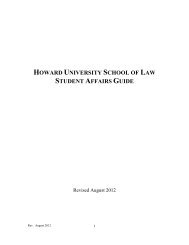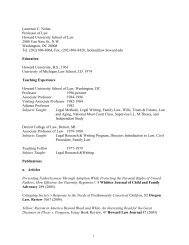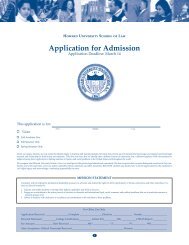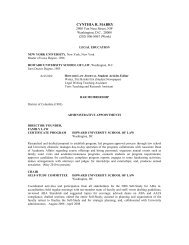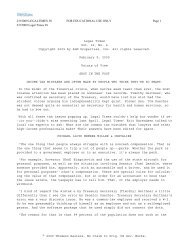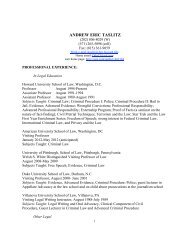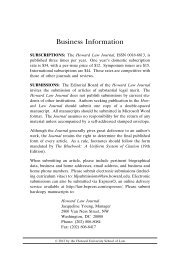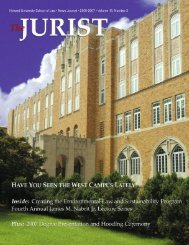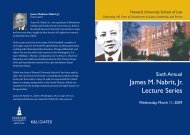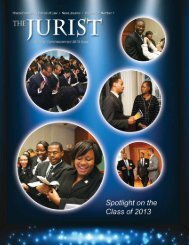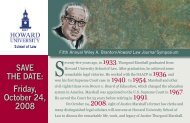Fisher v. University of Texas (on behalf of the Civil Rights Clinic)
Fisher v. University of Texas (on behalf of the Civil Rights Clinic)
Fisher v. University of Texas (on behalf of the Civil Rights Clinic)
You also want an ePaper? Increase the reach of your titles
YUMPU automatically turns print PDFs into web optimized ePapers that Google loves.
No. 11-345IN THESupreme Court <str<strong>on</strong>g>of</str<strong>on</strong>g> <strong>the</strong> United States————ABIGAIL NOEL FISHER,Petiti<strong>on</strong>er,v.UNIVERSITY OF TEXAS AT AUSTIN, ET AL.,Resp<strong>on</strong>dents.————On Writ <str<strong>on</strong>g>of</str<strong>on</strong>g> Certiorari to <strong>the</strong>United States Court <str<strong>on</strong>g>of</str<strong>on</strong>g> Appealsfor <strong>the</strong> Fifth Circuit————BRIEF FOR THEHOWARD UNIVERSITY SCHOOL OF LAWCIVIL RIGHTS CLINIC AS AMICUS CURIAEIN SUPPORT OF RESPONDENTS————ADERSON B. FRANÇOISCounsel <str<strong>on</strong>g>of</str<strong>on</strong>g> RecordLISA A. CROOMSAJMEL QUERESHIHOWARD UNIVERSITYSCHOOL OF LAWCIVIL RIGHTS CLINIC2900 Van Ness Street NWWashingt<strong>on</strong>, DC(202) 806-8065Afrancois@law.howard.eduAugust 13, 2012[Additi<strong>on</strong>al Amici Listed <strong>on</strong> Inside Cover]WILSON-EPES PRINTING CO., INC. – (202) 789-0096 – WASHINGTON, D. C. 20002
The following members <str<strong>on</strong>g>of</str<strong>on</strong>g> <strong>the</strong> Howard <str<strong>on</strong>g>University</str<strong>on</strong>g> School<str<strong>on</strong>g>of</str<strong>on</strong>g> Law faculty join this brief as amici curiae:SPENCER H. BOYERPr<str<strong>on</strong>g>of</str<strong>on</strong>g>essor <str<strong>on</strong>g>of</str<strong>on</strong>g> LawALICE GRESHAM BULLOCKPr<str<strong>on</strong>g>of</str<strong>on</strong>g>essor <str<strong>on</strong>g>of</str<strong>on</strong>g> LawOKIANER CHRISTIAN DARKInterim Dean andPr<str<strong>on</strong>g>of</str<strong>on</strong>g>essor <str<strong>on</strong>g>of</str<strong>on</strong>g> LawLENESE HERBERTVisiting Pr<str<strong>on</strong>g>of</str<strong>on</strong>g>essor <str<strong>on</strong>g>of</str<strong>on</strong>g> LawHOMER C. LARUEPr<str<strong>on</strong>g>of</str<strong>on</strong>g>essor <str<strong>on</strong>g>of</str<strong>on</strong>g> LawWARNER LAWSON, JR.Pr<str<strong>on</strong>g>of</str<strong>on</strong>g>essor <str<strong>on</strong>g>of</str<strong>on</strong>g> LawCYNTHIA R. MABRYPr<str<strong>on</strong>g>of</str<strong>on</strong>g>essor <str<strong>on</strong>g>of</str<strong>on</strong>g> LawHAROLD H. MACDOUGALLPr<str<strong>on</strong>g>of</str<strong>on</strong>g>essor <str<strong>on</strong>g>of</str<strong>on</strong>g> LawLATEEF MTIMAPr<str<strong>on</strong>g>of</str<strong>on</strong>g>essor <str<strong>on</strong>g>of</str<strong>on</strong>g> LawDirector Institute forIntellectual Property andSocial JusticeCHERYL C. NICHOLSAssociate Pr<str<strong>on</strong>g>of</str<strong>on</strong>g>essor <str<strong>on</strong>g>of</str<strong>on</strong>g> LawMARIELA OLIVARESAssistant Pr<str<strong>on</strong>g>of</str<strong>on</strong>g>essor <str<strong>on</strong>g>of</str<strong>on</strong>g> LawW. SHERMAN ROGERSPr<str<strong>on</strong>g>of</str<strong>on</strong>g>essor <str<strong>on</strong>g>of</str<strong>on</strong>g> LawJOSEPHINE ROSSAssociate Pr<str<strong>on</strong>g>of</str<strong>on</strong>g>essor <str<strong>on</strong>g>of</str<strong>on</strong>g> LawKURT L. SCHMOKEPr<str<strong>on</strong>g>of</str<strong>on</strong>g>essor <str<strong>on</strong>g>of</str<strong>on</strong>g> LawVALERIE SCHNEIDERAssistant Pr<str<strong>on</strong>g>of</str<strong>on</strong>g>essor <str<strong>on</strong>g>of</str<strong>on</strong>g> LawPATRICIA M. WORTHYPr<str<strong>on</strong>g>of</str<strong>on</strong>g>essor <str<strong>on</strong>g>of</str<strong>on</strong>g> Law
TABLE OF CONTENTSPageTABLE OF AUTHORITIES ................................ivINTEREST OF AMICI CURIAE ........................ 1SUMMARY OF ARGUMENT ............................. 2ARGUMENT ........................................................ 4I. INSTITUTIONAL ACADEMIC AUTONOMY ISCONSTITUTIONALLY-PROTECTED AND MUSTBE TAKEN INTO ACCOUNT WHENASSESSING THE CONSTITUTIONALITY OF ACOLLEGE OR UNIVERSITY RACE-BASEDADMISSIONS POLICY ..................................... 4A. Academic Aut<strong>on</strong>omy, Including <strong>the</strong>Freedom to Determine Who MayStudy at a <str<strong>on</strong>g>University</str<strong>on</strong>g>, Is a SpecialC<strong>on</strong>cern <str<strong>on</strong>g>of</str<strong>on</strong>g> <strong>the</strong> First Amendment ......... 4B. Academic Freedom is Also Groundedin a L<strong>on</strong>gstanding Judicial Traditi<strong>on</strong><str<strong>on</strong>g>of</str<strong>on</strong>g> Deference to Expert Decisi<strong>on</strong>s Madein Good Faith ......................................... 9C. A <str<strong>on</strong>g>University</str<strong>on</strong>g>’s Choice <str<strong>on</strong>g>of</str<strong>on</strong>g> StandardsGoverning <strong>the</strong> Selecti<strong>on</strong> <str<strong>on</strong>g>of</str<strong>on</strong>g> its StudentBody Merits <strong>the</strong> Deference AccordedO<strong>the</strong>r Academic Decisi<strong>on</strong>s .................... 12II. THE COURT’S DECISIONS AFFORDINGCOLLEGES AND UNIVERSITIES DEFERENCEREFLECT AN APPROPRIATE LEVEL OFCONCERN FOR THE CONSTITUTIONALRIGHTS OF STUDENTS ................................. 15(i)
iiTABLE OF CONTENTS—C<strong>on</strong>tinuedPageA. The Program May Not Set AsideSeats for Minority Applicants ............. 19B. The Program Must C<strong>on</strong>sider EachApplicati<strong>on</strong> <strong>on</strong> an Individual Basis .... 19C. Race May not be Used Mechanicallyto Admit or Deny a Student, but MayBe C<strong>on</strong>sidered a Plus, Al<strong>on</strong>g WithO<strong>the</strong>r Favorable Aspects <str<strong>on</strong>g>of</str<strong>on</strong>g> <strong>the</strong>Applicati<strong>on</strong> ........................................... 21D. A <str<strong>on</strong>g>University</str<strong>on</strong>g> May Only Adopt aRace-C<strong>on</strong>scious Program After C<strong>on</strong>sideringRace-Neutral Alternativesand Then Must Periodically Review<strong>the</strong> Program’s Necessity ...................... 22E. These Limitati<strong>on</strong>s Sufficiently Protect<strong>the</strong> <strong>Rights</strong> <str<strong>on</strong>g>of</str<strong>on</strong>g> Academic Instituti<strong>on</strong>sand Students............................... 24III. THE CIRCUIT COURTS’ DECISION INFISHER PROPERLY REFLECTS A RESPECTFOR THE DEFERENCE DUE INSTITUTIONSOF HIGHER EDUCATION AND THECONSTITUTIONAL RIGHTS OF STUDENTS .... 26A. The <str<strong>on</strong>g>University</str<strong>on</strong>g> <str<strong>on</strong>g>of</str<strong>on</strong>g> <str<strong>on</strong>g>Texas</str<strong>on</strong>g> Has L<strong>on</strong>gUnderstood, for Good Reas<strong>on</strong>, thatStudent Body Diversity Is Central toits Educati<strong>on</strong>al Missi<strong>on</strong> ....................... 27
iiiTABLE OF CONTENTS—C<strong>on</strong>tinuedPageB. Understanding <strong>the</strong> Importance <str<strong>on</strong>g>of</str<strong>on</strong>g>Student Body Diversity, <strong>the</strong> <str<strong>on</strong>g>University</str<strong>on</strong>g><str<strong>on</strong>g>of</str<strong>on</strong>g> <str<strong>on</strong>g>Texas</str<strong>on</strong>g> Has Crafted a ProgramNarrowly Tailored to Meet ThisCompelling Interest ............................. 29CONCLUSION .................................................... 35
CASESivTABLE OF AUTHORITIESPageAdarand C<strong>on</strong>structors, Inc. v. Pena, 515U.S. 200 (1995) ....................................... 3, 15, 17Board <str<strong>on</strong>g>of</str<strong>on</strong>g> Curators <str<strong>on</strong>g>of</str<strong>on</strong>g> <str<strong>on</strong>g>University</str<strong>on</strong>g> <str<strong>on</strong>g>of</str<strong>on</strong>g> Missouriv. Horowitz, 435 U.S. (1978)............ 7, 8Chevr<strong>on</strong>, U.S.A., Inc. v. Natural Res. Def.Council, Inc., 467 U.S. 837 (1984) ......... 9, 10, 11Christian Legal Soc. Chapter <str<strong>on</strong>g>of</str<strong>on</strong>g> <strong>the</strong> Univ.<str<strong>on</strong>g>of</str<strong>on</strong>g> California, Hastings Coll. <str<strong>on</strong>g>of</str<strong>on</strong>g> <strong>the</strong> Lawv. Martinez, 130 S. Ct. 2971 (2010) .......... 7, 8City <str<strong>on</strong>g>of</str<strong>on</strong>g> Richm<strong>on</strong>d v. J.A. Cros<strong>on</strong>, 488 U.S.469 (1989) ............................................. 17, 22, 23Cutter v. Wilkins<strong>on</strong>, 544 U.S. 709 (2005) .... 3, 17Edwards’ Lessee v. Darby, 25 U.S. 206(1827) .......................................................... 10, 11<str<strong>on</strong>g>Fisher</str<strong>on</strong>g> v. Univ. <str<strong>on</strong>g>of</str<strong>on</strong>g> Tex., 631 F.3d 213 (2011) 3, 27Gomilli<strong>on</strong> v. Lightfoot, 364 U.S. 339 (1960) ... 3, 17G<strong>on</strong>zales v. O Centro Espirita BeneficenteUniao do Vegetal, 546 U.S. 418 (2006) ..... 3, 17Gratz v. Bollinger, 539 U.S. 244(2003) ........................................ 12, 16, 17, 20, 30Grutter v. Bollinger, 539 U.S. 306 (2003) ... passimHopwood v. <str<strong>on</strong>g>Texas</str<strong>on</strong>g>, 78 F.3d 932 (5th Cir.1996) .......................................................... 27, 32Johns<strong>on</strong> v. California, 543 U.S. 499 (2005) . 3, 16J<strong>on</strong>es v. N. Carolina Pris<strong>on</strong>ers’ LaborUni<strong>on</strong>, Inc., 433 U.S. 119 (1977) .............. 11
vTABLE OF AUTHORITIES—C<strong>on</strong>tinuedPage(s)Keyishian v. Bd. <str<strong>on</strong>g>of</str<strong>on</strong>g> Regents <str<strong>on</strong>g>of</str<strong>on</strong>g> Univ. <str<strong>on</strong>g>of</str<strong>on</strong>g>State <str<strong>on</strong>g>of</str<strong>on</strong>g> N. Y., 385 U.S. 589 (1967) ........... 5, 7Lawt<strong>on</strong> v. Steele, 152 U.S. 133 (1894) ......... 11Parents Involved in Cmty. Sch. v.Seattle Sch. Dist. No. 1, 551 U.S. 701(2007) ........................................ 12, 18, 20, 21, 23Pell v. Procunier, 417 U.S. 817 (1974) ......... 11Regents <str<strong>on</strong>g>of</str<strong>on</strong>g> Univ. <str<strong>on</strong>g>of</str<strong>on</strong>g> Calif. v. Bakke 438U.S. 265 (1978) ......................................... passimRegents <str<strong>on</strong>g>of</str<strong>on</strong>g> Univ. <str<strong>on</strong>g>of</str<strong>on</strong>g> Mich. v. Ewing, 474U.S. 214 (1985) ..................................... 6, 7, 8, 12Shaw v. Hunt, 517 U.S. 908 (1996) ............. 18Sweatt v. Painter, 339 U.S. 629 (1950) ........ 14Sweezy v. New Hampshire, 354 U.S. 234(1957) ......................................................... 2, 5, 8United States v. Virginia, 518 U.S. 515(1996) ......................................................... 12Univ. <str<strong>on</strong>g>of</str<strong>on</strong>g> Pa. v. EEOC, 493 U.S. 182 (1990) 8Wygant v. Jacks<strong>on</strong> Bd. <str<strong>on</strong>g>of</str<strong>on</strong>g> Educ., 476 U.S.267 (1986) ................................................. passimCONSTITUTIONU.S. C<strong>on</strong>st. amend. I ................................... passimU.S. C<strong>on</strong>st. amend. XIV ............................... 8
viTABLE OF AUTHORITIES—C<strong>on</strong>tinuedOTHER AUTHORITIESPage(s)Academic Freedom Committees <str<strong>on</strong>g>of</str<strong>on</strong>g> <strong>the</strong><str<strong>on</strong>g>University</str<strong>on</strong>g> <str<strong>on</strong>g>of</str<strong>on</strong>g> Cape Town and <str<strong>on</strong>g>University</str<strong>on</strong>g><str<strong>on</strong>g>of</str<strong>on</strong>g> Witswatersrand, Johannesburg, TheOpen Universities in South Africa (1957reprinted in 1974) ..................................... 5J. Peter Byrne, Academic Freedom: “ASpecial C<strong>on</strong>cern <str<strong>on</strong>g>of</str<strong>on</strong>g> <strong>the</strong> First Amendment”,99 Yale L. Rev. 251 (1989) ............ 6, 7James Baldwin, The Fire Next Time,collected in The Price <str<strong>on</strong>g>of</str<strong>on</strong>g> The Ticket (St.Martin’s Press 1985) ................................. 34Neal Kumar Katyal, The Promise andPrec<strong>on</strong>diti<strong>on</strong> <str<strong>on</strong>g>of</str<strong>on</strong>g> Educati<strong>on</strong>al Aut<strong>on</strong>omy,31 Hastings C<strong>on</strong>st. L. Q. 557 (2004) ........ 10Paul Horwitz, Universities as FirstAmendment Instituti<strong>on</strong>s: Some EasyAnswers and Hard Questi<strong>on</strong>s, 54U.C.L.A. L. Rev. 1497 (2007) ................... 6, 7, 17W.E.B. Dubois, The Soul <str<strong>on</strong>g>of</str<strong>on</strong>g> Black Folks(Bedford Books 1903) ................................ 34William O. Douglas, VALUES OF FREESPEECH IN AN ALMANAC OF LIBERTY(Doubleday & Co., Inc. Garden City, NY1954) .......................................................... 4
INTEREST OF AMICI CURIAE 1Amici curiae are faculty members at Howard <str<strong>on</strong>g>University</str<strong>on</strong>g>School <str<strong>on</strong>g>of</str<strong>on</strong>g> Law and attorneys in <strong>the</strong> LawSchool’s <strong>Civil</strong> <strong>Rights</strong> <strong>Clinic</strong>. While Howard is <str<strong>on</strong>g>of</str<strong>on</strong>g>tenreferred to as <strong>on</strong>e <str<strong>on</strong>g>of</str<strong>on</strong>g> <strong>the</strong> nati<strong>on</strong>’s premier historicallyblack universities, for nearly 150 years <strong>the</strong> <str<strong>on</strong>g>University</str<strong>on</strong>g>’smissi<strong>on</strong> has actually been to provide a premiereducati<strong>on</strong> to all regardless <str<strong>on</strong>g>of</str<strong>on</strong>g> race. Our history <str<strong>on</strong>g>of</str<strong>on</strong>g>integrated educati<strong>on</strong> has taught us that <strong>the</strong> practice<str<strong>on</strong>g>of</str<strong>on</strong>g> diversity is never a simple matter <str<strong>on</strong>g>of</str<strong>on</strong>g> just saying noto race or using <strong>on</strong>e <str<strong>on</strong>g>of</str<strong>on</strong>g> its supposedly more palatableproxies such as socio-ec<strong>on</strong>omic status. If achievingdiversity was such an easy thing, surely by now mosthigher educati<strong>on</strong> instituti<strong>on</strong>s would have figured outhow to do it through race-blind measures instead <str<strong>on</strong>g>of</str<strong>on</strong>g>inviting up<strong>on</strong> <strong>the</strong>ir heads <strong>the</strong> sort <str<strong>on</strong>g>of</str<strong>on</strong>g> c<strong>on</strong>stituti<strong>on</strong>alchallenges that seem to recur with remarkablefrequency no matter how clearly this Court, as it didin Grutter v. Bollinger, 539 U.S. 306 (2003), removesc<strong>on</strong>stituti<strong>on</strong>al doubt from <strong>the</strong> issue. For a moderncollege and university, achieving <strong>the</strong> sort <str<strong>on</strong>g>of</str<strong>on</strong>g> studentbody diversity that will provide thoughtful leadershipin our technocratic, multicultural and democraticsociety requires incalculably complex judgments.Therefore, when, as is <strong>the</strong> case for <strong>the</strong> <str<strong>on</strong>g>University</str<strong>on</strong>g> <str<strong>on</strong>g>of</str<strong>on</strong>g><str<strong>on</strong>g>Texas</str<strong>on</strong>g> at Austin (“UT Austin”), an instituti<strong>on</strong> takesrace into account as part <str<strong>on</strong>g>of</str<strong>on</strong>g> a good faith effort atachieving diversity, for <strong>the</strong> sake <str<strong>on</strong>g>of</str<strong>on</strong>g> academic1Pursuant to Supreme Court Rule 37, this brief is filed with<strong>the</strong> written c<strong>on</strong>sent <str<strong>on</strong>g>of</str<strong>on</strong>g> all parties. The parties’ c<strong>on</strong>sent lettersare <strong>on</strong> file with <strong>the</strong> Court. This brief has not been authored,ei<strong>the</strong>r in whole or in part, by counsel for any party, and nopers<strong>on</strong> or entity, o<strong>the</strong>r than amicus curiae or <strong>the</strong>ir counsel hasmade a m<strong>on</strong>etary c<strong>on</strong>tributi<strong>on</strong> to <strong>the</strong> preparati<strong>on</strong> or submissi<strong>on</strong><str<strong>on</strong>g>of</str<strong>on</strong>g> this brief.
2aut<strong>on</strong>omy and out <str<strong>on</strong>g>of</str<strong>on</strong>g> respect for its expertise, itsdecisi<strong>on</strong> deserves judicial deference.We submit this brief in support <str<strong>on</strong>g>of</str<strong>on</strong>g> resp<strong>on</strong>dents inorder to respectfully urge this H<strong>on</strong>orable Court touphold <strong>the</strong> decisi<strong>on</strong> <str<strong>on</strong>g>of</str<strong>on</strong>g> <strong>the</strong> United States Court <str<strong>on</strong>g>of</str<strong>on</strong>g>Appeals for <strong>the</strong> Fifth Circuit, affirm its own holdingin Grutter and find that UT Austin acted within itsc<strong>on</strong>stituti<strong>on</strong>ally protected z<strong>on</strong>e <str<strong>on</strong>g>of</str<strong>on</strong>g> academic aut<strong>on</strong>omywhen it reintroduced race as <strong>on</strong>e factor in its admissi<strong>on</strong>decisi<strong>on</strong>s in order to seek <strong>the</strong> educati<strong>on</strong>albenefits flowing from diversity.SUMMARY OF ARGUMENTUniversities “occupy a special niche in our c<strong>on</strong>stituti<strong>on</strong>altraditi<strong>on</strong>.” Grutter, 539 U.S. at 329. Thisspecial niche is rooted in <strong>the</strong> First Amendment whichprovides that, within c<strong>on</strong>stituti<strong>on</strong>al limits, a universityis free to determine <strong>on</strong> academic grounds “whomay teach, what may be taught, how it shall betaught, and who may be admitted to study.” Sweezyv. New Hampshire, 354 U.S. 234, 263 (1957). In <strong>the</strong>c<strong>on</strong>text <str<strong>on</strong>g>of</str<strong>on</strong>g> student body selecti<strong>on</strong>, <strong>the</strong> respect for academicaut<strong>on</strong>omy has manifested itself in <strong>the</strong> Court’sdeference to a university’s good faith determinati<strong>on</strong>that a compelling state interest in student bodydiversity exists and that race can be <strong>on</strong>e <str<strong>on</strong>g>of</str<strong>on</strong>g> <strong>the</strong> factorsc<strong>on</strong>sidered in pursuit <str<strong>on</strong>g>of</str<strong>on</strong>g> such.The Court’s deference is nei<strong>the</strong>r without good reas<strong>on</strong>nor without c<strong>on</strong>stituti<strong>on</strong>al limits. A diverse classnot <strong>on</strong>ly benefits classroom discussi<strong>on</strong> but alsoprovides <strong>the</strong> opportunity for cross-cultural understandingin social settings. Additi<strong>on</strong>ally, <strong>the</strong> maintenance<str<strong>on</strong>g>of</str<strong>on</strong>g> a diverse student body communicates to <strong>the</strong>general public <strong>the</strong> university’s willingness to engagediverse viewpoints – a necessary part <str<strong>on</strong>g>of</str<strong>on</strong>g> a vibrant
3academic envir<strong>on</strong>ment. At <strong>the</strong> same time, in requiringthat a university’s efforts at diversity be narrowlytailored, <strong>the</strong> Court has held that any program mustrespect <strong>the</strong> rights <str<strong>on</strong>g>of</str<strong>on</strong>g> each student by c<strong>on</strong>sidering raceas part <str<strong>on</strong>g>of</str<strong>on</strong>g> a holistic assessment <str<strong>on</strong>g>of</str<strong>on</strong>g> all <strong>the</strong> diversecharacteristics <str<strong>on</strong>g>of</str<strong>on</strong>g> each applicant. Moreover, while auniversity need not have chosen <strong>the</strong> least restrictivemeans to achieve <strong>the</strong> benefits <str<strong>on</strong>g>of</str<strong>on</strong>g> diversity, it musthave c<strong>on</strong>sidered alternatives. That <strong>the</strong> Court struckthis balance, in Grutter, did not c<strong>on</strong>stitute an aband<strong>on</strong>ment<str<strong>on</strong>g>of</str<strong>on</strong>g> strict scrutiny but simply ano<strong>the</strong>r manifestati<strong>on</strong><str<strong>on</strong>g>of</str<strong>on</strong>g> <strong>the</strong> well-founded principle that c<strong>on</strong>textmatters. See Grutter, 539 U.S. at 331-32; see alsoG<strong>on</strong>zales v. O Centro Espirita Beneficente Uniao doVegetal, 546 U.S. 418, 431-32 (2006); Cutter v. Wilkins<strong>on</strong>,544 U.S. 709, 723 (2005); Johns<strong>on</strong> v. California,543 U.S. 499, 515 (2005) Adarand C<strong>on</strong>structors,Inc. v. Pena, 515 U.S. 200, 228 (1995); Gomilli<strong>on</strong> v.Lightfoot, 364 U.S. 339, 343-44 (1960).UT Austin tried and failed to achieve diversity inits classrooms using purely race-blind alternatives.Since 1997, UT Austin’s main admissi<strong>on</strong> policy hasbeen <strong>the</strong> “Top-Ten Percent Plan” (Plan), pursuant towhich a <str<strong>on</strong>g>Texas</str<strong>on</strong>g> high school student who graduates in<strong>the</strong> top ten percent <str<strong>on</strong>g>of</str<strong>on</strong>g> his or her class is admitted to<strong>the</strong> <str<strong>on</strong>g>University</str<strong>on</strong>g>. After two separate studies found that,in spite <str<strong>on</strong>g>of</str<strong>on</strong>g> <strong>the</strong> plan, UT Austin would not be diversewithout employing race as a factor in admissi<strong>on</strong>s, UTAustin created a supplement to <strong>the</strong> Plan, pursuant towhich race is used as <strong>on</strong>e <str<strong>on</strong>g>of</str<strong>on</strong>g> multiple c<strong>on</strong>siderati<strong>on</strong>sto holistically evaluate students not admitted as aTen-Percenter. <str<strong>on</strong>g>Fisher</str<strong>on</strong>g> v. Univ. <str<strong>on</strong>g>of</str<strong>on</strong>g> Tex., 631 F.3d 213,224-225 (2011).
4The race-neutral Plan remains UT Austin’sprimary admissi<strong>on</strong>s policy; meanwhile, <strong>the</strong> holisticreview program remains extremely narrow in scope.N<strong>on</strong>e<strong>the</strong>less, <strong>the</strong> program c<strong>on</strong>tinues to produce <strong>the</strong>benefits <strong>the</strong> <str<strong>on</strong>g>University</str<strong>on</strong>g> envisi<strong>on</strong>ed: a more diverse,racially as well as o<strong>the</strong>rwise, student body. This hasresulted from both <strong>the</strong> diverse students admitted via<strong>the</strong> challenged program and students <str<strong>on</strong>g>of</str<strong>on</strong>g> all races andbackgrounds drawn to <strong>the</strong> <str<strong>on</strong>g>University</str<strong>on</strong>g> because <str<strong>on</strong>g>of</str<strong>on</strong>g> <strong>the</strong>percepti<strong>on</strong> and reality <str<strong>on</strong>g>of</str<strong>on</strong>g> <strong>the</strong> campus as an openacademic envir<strong>on</strong>ment.ARGUMENTI. INSTITUTIONAL ACADEMIC AUTONOMY ISCONSTITUTIONALLY-PROTECTED AND MUSTBE TAKEN INTO ACCOUNT WHEN ASSESSINGTHE CONSTITUTIONALITY OF A COLLEGE ORUNIVERSITY RACE-BASED ADMISSIONS POLICYA. Academic Aut<strong>on</strong>omy, Including <strong>the</strong>Freedom to Determine Who May Studyat a <str<strong>on</strong>g>University</str<strong>on</strong>g>, Is a Special C<strong>on</strong>cern <str<strong>on</strong>g>of</str<strong>on</strong>g><strong>the</strong> First AmendmentBut <strong>the</strong> most important aspect <str<strong>on</strong>g>of</str<strong>on</strong>g> freedom <str<strong>on</strong>g>of</str<strong>on</strong>g>speech is freedom to learn . . . All educati<strong>on</strong>is a c<strong>on</strong>tinuing dialogue – questi<strong>on</strong>s andanswers that pursue every problem to <strong>the</strong>horiz<strong>on</strong>. That is <strong>the</strong> essence <str<strong>on</strong>g>of</str<strong>on</strong>g> academicfreedom . . . 2As a result <str<strong>on</strong>g>of</str<strong>on</strong>g> <strong>the</strong> “expansive freedoms <str<strong>on</strong>g>of</str<strong>on</strong>g> speechand thought associated with <strong>the</strong> university envir<strong>on</strong>ment,universities occupy a special niche in ourc<strong>on</strong>stituti<strong>on</strong>al traditi<strong>on</strong>.” Grutter 539 U.S at 329; see2William O. Douglas, VALUES OF FREE SPEECH IN AN ALMANACOF LIBERTY 363 (Doubleday & Co., Inc. Garden City, NY 1954).
5also Regents <str<strong>on</strong>g>of</str<strong>on</strong>g> Univ. <str<strong>on</strong>g>of</str<strong>on</strong>g> Calif. v. Bakke 438 U.S. 265,312-13 (1978) (opini<strong>on</strong> <str<strong>on</strong>g>of</str<strong>on</strong>g> Powell, J.) ((“[a]cademicfreedom, though not a specifically enumerated c<strong>on</strong>stituti<strong>on</strong>alright, l<strong>on</strong>g has been viewed as a specialc<strong>on</strong>cern <str<strong>on</strong>g>of</str<strong>on</strong>g> <strong>the</strong> First Amendment.”). Academic freedom,as a c<strong>on</strong>stituti<strong>on</strong>al c<strong>on</strong>cern, “stems from “[t]heessentiality <str<strong>on</strong>g>of</str<strong>on</strong>g> freedom in <strong>the</strong> community <str<strong>on</strong>g>of</str<strong>on</strong>g> AmericanUniversities” which this Court has c<strong>on</strong>cluded “isalmost self-evident.” Sweezy, 354 U.S. at 250; see alsoKeyishian v. Bd. <str<strong>on</strong>g>of</str<strong>on</strong>g> Regents <str<strong>on</strong>g>of</str<strong>on</strong>g> Univ. <str<strong>on</strong>g>of</str<strong>on</strong>g> State <str<strong>on</strong>g>of</str<strong>on</strong>g> N. Y.,385 U.S. 589, 603 (1967) (“[o]ur Nati<strong>on</strong> is deeplycommitted to safeguarding academic freedom, whichis… a special c<strong>on</strong>cern <str<strong>on</strong>g>of</str<strong>on</strong>g> <strong>the</strong> First Amendment”).The First Amendment protects universities as <strong>the</strong>yprovide that atmosphere which is most c<strong>on</strong>duciveto speculati<strong>on</strong>, experiment and creati<strong>on</strong>. It is anatmosphere in which <strong>the</strong>re prevail ‘<strong>the</strong> fouressential freedoms’ <str<strong>on</strong>g>of</str<strong>on</strong>g> a university-to determinefor itself <strong>on</strong> academic grounds who may teach,what may be taught, how it shall be taught, andwho may be admitted to study.’Sweezy, 354 U.S. at 263 (citing Academic FreedomCommittees <str<strong>on</strong>g>of</str<strong>on</strong>g> <strong>the</strong> <str<strong>on</strong>g>University</str<strong>on</strong>g> <str<strong>on</strong>g>of</str<strong>on</strong>g> Cape Town and <str<strong>on</strong>g>University</str<strong>on</strong>g><str<strong>on</strong>g>of</str<strong>on</strong>g> Witswatersrand, Johannesburg, The OpenUniversities in South Africa 11-12 (1957 reprinted in1974).) 3Thus, “academic freedom thrives not <strong>on</strong>ly <strong>on</strong>3In 1957, members <str<strong>on</strong>g>of</str<strong>on</strong>g> <strong>the</strong> faculties <str<strong>on</strong>g>of</str<strong>on</strong>g> “<strong>the</strong> Universities <str<strong>on</strong>g>of</str<strong>on</strong>g>Cape Town and Witwatersrand declared <strong>the</strong>ir oppositi<strong>on</strong> to”apar<strong>the</strong>id’s attempt to exclude African, Asian and Colouredstudents from universities <strong>the</strong> Nati<strong>on</strong>al Party governmentreserved for white students. As those who reissued <strong>the</strong> report in1974 noted, “much <str<strong>on</strong>g>of</str<strong>on</strong>g> <strong>the</strong> 1957 study was devoted to an expositi<strong>on</strong><str<strong>on</strong>g>of</str<strong>on</strong>g> [<strong>the</strong>] aspect <str<strong>on</strong>g>of</str<strong>on</strong>g> [academic] freedom [that involved whoshould be admitted to study] and its importance to SouthAfrican society.” The Open Universities in South Africa at p. 1
6<strong>the</strong> independent and uninhibited exchange <str<strong>on</strong>g>of</str<strong>on</strong>g> ideasam<strong>on</strong>g teachers and students, but also, andsomewhat inc<strong>on</strong>sistently, <strong>on</strong> aut<strong>on</strong>omous decisi<strong>on</strong>makingby <strong>the</strong> academy itself.” Regents <str<strong>on</strong>g>of</str<strong>on</strong>g> Univ. <str<strong>on</strong>g>of</str<strong>on</strong>g>Mich. v. Ewing, 474 U.S. 214, 226 (1985); see alsoBakke, 438 U.S. at 312 (opini<strong>on</strong> <str<strong>on</strong>g>of</str<strong>on</strong>g> Powell, J.) (“[t]hefreedom <str<strong>on</strong>g>of</str<strong>on</strong>g> a university to make its own judgments asto educati<strong>on</strong> includes <strong>the</strong> selecti<strong>on</strong> <str<strong>on</strong>g>of</str<strong>on</strong>g> its studentbody.”). As <strong>on</strong>e <str<strong>on</strong>g>of</str<strong>on</strong>g> <strong>the</strong> foremost scholars <str<strong>on</strong>g>of</str<strong>on</strong>g> academicfreedom aptly puts it:[T]he university is <strong>the</strong> preeminent instituti<strong>on</strong> inour society where knowledge and understandingare pursued with detachment or disinterestedness. . . Disinterested scholarship and researchare both goods in <strong>the</strong>mselves and benefits tosociety as a whole. . . . The disinterested searchfor knowledge fosters a manner <str<strong>on</strong>g>of</str<strong>on</strong>g> discourse that,at its best, is careful, critical, and ambitious.Again, <strong>the</strong> method <str<strong>on</strong>g>of</str<strong>on</strong>g> discourse is both a goodin itself and a benefit to society. [S]cholarlydiscourse creates <strong>the</strong> most favorable envir<strong>on</strong>mentin which thinkers may formulate ideas thatstand apart from popular opini<strong>on</strong> or fashi<strong>on</strong>ableerror. . . . The university aspires to instill inthose entering adulthood a capacity for matureand independent judgment. The elements <str<strong>on</strong>g>of</str<strong>on</strong>g> thisliberal educati<strong>on</strong>, which are c<strong>on</strong>stantly revisedand challenged, inform <strong>the</strong> student <str<strong>on</strong>g>of</str<strong>on</strong>g> <strong>the</strong>knowledge valued from <strong>the</strong> past, c<strong>on</strong>vey <strong>the</strong>methodological rudiments <str<strong>on</strong>g>of</str<strong>on</strong>g> critical thought, andfoster <strong>the</strong> capacity for independent and measuredthinking.J. Peter Byrne, Academic Freedom: “A Special C<strong>on</strong>cern<str<strong>on</strong>g>of</str<strong>on</strong>g> <strong>the</strong> First Amendment”, 99 Yale L. Rev. 251,333-35 (1989); see also Paul Horwitz, Universities as
7First Amendment Instituti<strong>on</strong>s: Some Easy Answersand Hard Questi<strong>on</strong>s, 54 U.C.L.A. L. Rev. 1497, 1501(2007) (advancing an instituti<strong>on</strong>al analysis <str<strong>on</strong>g>of</str<strong>on</strong>g> <strong>the</strong>First Amendment under which colleges and universitiesdeserve judicial deference when engaged inacademic decisi<strong>on</strong>-making).Fur<strong>the</strong>rmore, practical “c<strong>on</strong>siderati<strong>on</strong>s <str<strong>on</strong>g>of</str<strong>on</strong>g> pr<str<strong>on</strong>g>of</str<strong>on</strong>g>oundimportance counsel restrained judicial review <str<strong>on</strong>g>of</str<strong>on</strong>g> <strong>the</strong>substance <str<strong>on</strong>g>of</str<strong>on</strong>g> academic decisi<strong>on</strong>s.” Ewing, 474 U.S. at225. Am<strong>on</strong>g <strong>the</strong>se c<strong>on</strong>siderati<strong>on</strong>s are <strong>the</strong> “lack <str<strong>on</strong>g>of</str<strong>on</strong>g>standards” by which to judge <strong>the</strong> instituti<strong>on</strong>’s choice,as well as “a reluctance to trench <strong>on</strong> <strong>the</strong> prerogatives<str<strong>on</strong>g>of</str<strong>on</strong>g> state and local educati<strong>on</strong>al instituti<strong>on</strong>s and [<strong>the</strong>judiciary’s] resp<strong>on</strong>sibility to safeguard <strong>the</strong>ir academicfreedom, ‘a special c<strong>on</strong>cern <str<strong>on</strong>g>of</str<strong>on</strong>g> <strong>the</strong> First Amendment.’”Ewing, 474 U.S. at 226 (citing Keyishian, 385 U.S. at603;) see also Christian Legal Soc. Chapter <str<strong>on</strong>g>of</str<strong>on</strong>g> <strong>the</strong>Univ. <str<strong>on</strong>g>of</str<strong>on</strong>g> California, Hastings Coll. <str<strong>on</strong>g>of</str<strong>on</strong>g> <strong>the</strong> Law v. Martinez,130 S. Ct. 2971, 2997 (2010) (Stevens, J. c<strong>on</strong>curring)(“Public universities serve a distinctive rolein a modern democratic society.”)Accordingly, judicial deference to academic instituti<strong>on</strong>sis based <strong>on</strong> two principles. First is <strong>the</strong> understandingthat “a liberal educati<strong>on</strong> is good in itself,both pleasant and virtuous, and a necessity forproviding competent leadership in a complex, technocratic,and democratic society.” Byrne, AcademicFreedom, 99 Yale L. Rev. at 335. Sec<strong>on</strong>d is <strong>the</strong>recogniti<strong>on</strong> that courts are ill-suited “to evaluate <strong>the</strong>substance <str<strong>on</strong>g>of</str<strong>on</strong>g> <strong>the</strong> multitude <str<strong>on</strong>g>of</str<strong>on</strong>g> academic decisi<strong>on</strong>s thatare made daily by faculty members <str<strong>on</strong>g>of</str<strong>on</strong>g> public educati<strong>on</strong>alinstituti<strong>on</strong>s.” Ewing, 474 U.S. at 226; see alsoHorwitz, 54 U.C.L.A. L. Rev. at 1501 (citing Ewingand Horowitz for <strong>the</strong> propositi<strong>on</strong> that deference is
8owed “to <strong>the</strong> ‘genuinely academic decisi<strong>on</strong>s’ <str<strong>on</strong>g>of</str<strong>on</strong>g> university<str<strong>on</strong>g>of</str<strong>on</strong>g>ficials.”)Historically, c<strong>on</strong>stituti<strong>on</strong>al respect for academicfreedom has meant that this Court will nei<strong>the</strong>rsec<strong>on</strong>d-guess nor overturn academic judgments madein good faith. See e.g., Ewing, 474 U.S. at 225((deferring substantially to an academic decisi<strong>on</strong> todismiss a student where <strong>the</strong> university reas<strong>on</strong>ablyexercised pr<str<strong>on</strong>g>of</str<strong>on</strong>g>essi<strong>on</strong>al judgment); Univ. <str<strong>on</strong>g>of</str<strong>on</strong>g> Pa. v.EEOC, 493 U.S. 182, 199 (1990) (stressing “<strong>the</strong>importance <str<strong>on</strong>g>of</str<strong>on</strong>g> avoiding sec<strong>on</strong>d-guessing <str<strong>on</strong>g>of</str<strong>on</strong>g> legitimateacademic judgments”); Sweezy, 354 U.S. at 263(reversing a university’s c<strong>on</strong>tempt c<strong>on</strong>victi<strong>on</strong> forrefusing to answer questi<strong>on</strong>s posed by <strong>the</strong> AttorneyGeneral regarding <strong>the</strong> c<strong>on</strong>tent <str<strong>on</strong>g>of</str<strong>on</strong>g> <strong>the</strong> pr<str<strong>on</strong>g>of</str<strong>on</strong>g>essor’slectures and his knowledge <str<strong>on</strong>g>of</str<strong>on</strong>g> communism); Board <str<strong>on</strong>g>of</str<strong>on</strong>g>Curators <str<strong>on</strong>g>of</str<strong>on</strong>g> <str<strong>on</strong>g>University</str<strong>on</strong>g> <str<strong>on</strong>g>of</str<strong>on</strong>g> Missouri v. Horowitz, 435U.S. at 96, n. 6 (Powell, J., c<strong>on</strong>curring) (noting that“[u]niversity faculties must have <strong>the</strong> widest range <str<strong>on</strong>g>of</str<strong>on</strong>g>discreti<strong>on</strong> in making judgments as to <strong>the</strong> academicperformance <str<strong>on</strong>g>of</str<strong>on</strong>g> students and <strong>the</strong>ir entitlement topromoti<strong>on</strong> or graduati<strong>on</strong>.”); Martinez, 130 S. Ct. at2997-98 (Stevens, J., c<strong>on</strong>curring) (sustaining <strong>the</strong>c<strong>on</strong>stituti<strong>on</strong>ality <str<strong>on</strong>g>of</str<strong>on</strong>g> a law school’s universal applicati<strong>on</strong><str<strong>on</strong>g>of</str<strong>on</strong>g> an organizati<strong>on</strong>al n<strong>on</strong>-discriminati<strong>on</strong> policy toall <str<strong>on</strong>g>of</str<strong>on</strong>g>ficially registered groups when challenged bycampus religious organizati<strong>on</strong>s who sought to excludehomosexual members as a violati<strong>on</strong> <str<strong>on</strong>g>of</str<strong>on</strong>g> First andFourteenth Amendment rights).Hence, when a court reviews a genuinely academicdecisi<strong>on</strong>, it may not override it “unless it is such asubstantial departure from accepted academic normsas to dem<strong>on</strong>strate that <strong>the</strong> pers<strong>on</strong> or committeeresp<strong>on</strong>sible did not actually exercise pr<str<strong>on</strong>g>of</str<strong>on</strong>g>essi<strong>on</strong>aljudgment.” Ewing, 474 U.S. at 225.
9B. Academic Freedom is Also Groundedin a L<strong>on</strong>gstanding Judicial Traditi<strong>on</strong><str<strong>on</strong>g>of</str<strong>on</strong>g> Deference to Expert Decisi<strong>on</strong>s Madein Good FaithAcademic freedom is also grounded in al<strong>on</strong>gstanding judicial traditi<strong>on</strong> <str<strong>on</strong>g>of</str<strong>on</strong>g> respecting <strong>the</strong> goodfaith decisi<strong>on</strong>s <str<strong>on</strong>g>of</str<strong>on</strong>g> properly charged experts. SeeChevr<strong>on</strong>, U.S.A., Inc. v. Natural Res. Def. Council,Inc., 467 U.S. 837, 844 (1984). In Chevr<strong>on</strong>, this Courtnoted that, when faced with a challenge to anadministrative agency’s c<strong>on</strong>structi<strong>on</strong> <str<strong>on</strong>g>of</str<strong>on</strong>g> a statutewithin its authorized jurisdicti<strong>on</strong> and in <strong>the</strong> absence<str<strong>on</strong>g>of</str<strong>on</strong>g> an unambiguous answer <strong>on</strong> <strong>the</strong> part <str<strong>on</strong>g>of</str<strong>on</strong>g> C<strong>on</strong>gress asto <strong>the</strong> precise questi<strong>on</strong> at issue, reviewing courtsshould generally defer to <strong>the</strong> agency’s own reas<strong>on</strong>ableinterpretati<strong>on</strong>. 467 U.S. at 842-44. Specifically, judicialdeference is warranted when (1) <strong>the</strong> issue beingchallenged is highly technical and complex; (2) judgeslack expertise in <strong>the</strong> field in questi<strong>on</strong>; (3) <strong>the</strong> governmentalactor did not act negligently in carryingout its <str<strong>on</strong>g>of</str<strong>on</strong>g>ficial duties; and (4) <strong>the</strong> governmental actorperformed its duties in a detailed and reas<strong>on</strong>ablefashi<strong>on</strong>. Id. at 865.To be sure, <strong>the</strong> Court has applied <strong>the</strong> Chevr<strong>on</strong>standard in <strong>the</strong> specific c<strong>on</strong>text <str<strong>on</strong>g>of</str<strong>on</strong>g> determiningwhe<strong>the</strong>r a federal agency, acting under c<strong>on</strong>gressi<strong>on</strong>alstatute, has exceeded <strong>the</strong> bounds <str<strong>on</strong>g>of</str<strong>on</strong>g> its authority.However, underlying Chevr<strong>on</strong> deference is a deeperc<strong>on</strong>cern that <strong>the</strong>re are instances when <strong>the</strong> judiciary isill equipped to render judgment and that in suchinstances courts are well served to defer to expertdecisi<strong>on</strong>s made in good faith and with care.
10In fact, <strong>the</strong> Chevr<strong>on</strong> doctrine did not originate in,nor has it been exclusively reserved for, <strong>the</strong> expertjudgments <str<strong>on</strong>g>of</str<strong>on</strong>g> federal administrative actors. SeeEdwards’ Lessee v. Darby, 25 U.S. 206 (1827). Ra<strong>the</strong>r,“federal courts routinely defer to all sorts <str<strong>on</strong>g>of</str<strong>on</strong>g> bodies:administrative agencies, pris<strong>on</strong> <str<strong>on</strong>g>of</str<strong>on</strong>g>ficials, expert witnesses,military <str<strong>on</strong>g>of</str<strong>on</strong>g>ficials, state administrators, and<strong>the</strong> like.” Neal Kumar Katyal, The Promise andPrec<strong>on</strong>diti<strong>on</strong> <str<strong>on</strong>g>of</str<strong>on</strong>g> Educati<strong>on</strong>al Aut<strong>on</strong>omy, 31 HastingsC<strong>on</strong>st. L. Q. 557, 563 (2004). In Darby, <strong>on</strong>e <str<strong>on</strong>g>of</str<strong>on</strong>g> <strong>the</strong>earlier cases <str<strong>on</strong>g>of</str<strong>on</strong>g> judicial deference, <strong>the</strong> Court wasasked to nullify a land tract survey made by delegatedcommissi<strong>on</strong>ers <str<strong>on</strong>g>of</str<strong>on</strong>g> <strong>the</strong> state <str<strong>on</strong>g>of</str<strong>on</strong>g> North Carolina.The Court, recognizing a substantial level <str<strong>on</strong>g>of</str<strong>on</strong>g> deferenceto be given to <strong>the</strong> commissi<strong>on</strong>ers’ decisi<strong>on</strong>s,explained that <strong>the</strong> “c<strong>on</strong>structi<strong>on</strong> <str<strong>on</strong>g>of</str<strong>on</strong>g> those who werecalled up<strong>on</strong> to act under <strong>the</strong> law, and were appointedto carry its provisi<strong>on</strong>s into effect, is entitled to verygreat respect.” Id. at 210. The Court agreed with <strong>the</strong>claimant in that <strong>the</strong> commissi<strong>on</strong>ers were not granted<strong>the</strong> express authority to survey as <strong>the</strong>y did, but n<strong>on</strong>e<strong>the</strong>lessheld that <strong>the</strong>y retained an implied authorityflowing from <strong>the</strong> statute that covered <strong>the</strong> scope <str<strong>on</strong>g>of</str<strong>on</strong>g><strong>the</strong>ir acti<strong>on</strong>. Id. at 209. The Court fur<strong>the</strong>r indicatedthat deference was warranted because <strong>the</strong> statelegislature enacted an additi<strong>on</strong>al statute, subsequentto <strong>the</strong> challenged acti<strong>on</strong>, expressly permitting <strong>the</strong>state actor to act as he did. Id. at 210. The Courtc<strong>on</strong>cluded, “[i]t was a public act, d<strong>on</strong>e by a publicauthorized agent <str<strong>on</strong>g>of</str<strong>on</strong>g> <strong>the</strong> government, and afterwardsrecognized [sic] by <strong>the</strong> government itself. N<strong>on</strong>e but<strong>the</strong> government itself ought, <strong>the</strong>refore, to be permittedto call it in questi<strong>on</strong>.” Id. at 211.
11The deference provided in Darby foreshadowedwhat was to come in Chevr<strong>on</strong>. The Court has repeatedlymade clear that courts should not be in <strong>the</strong> business<str<strong>on</strong>g>of</str<strong>on</strong>g> substituting <strong>the</strong>ir own judgments for those <str<strong>on</strong>g>of</str<strong>on</strong>g>experts rendered in good faith when sensible mindscan reas<strong>on</strong>ably differ about <strong>the</strong> wisdom <str<strong>on</strong>g>of</str<strong>on</strong>g> thoseexpert decisi<strong>on</strong>s. See, e.g. Lawt<strong>on</strong> v. Steele, 152 U.S.133, 140 (1894) (holding state actors operating understate statute not liable for damage caused to plaintiffs’property stemming from a reas<strong>on</strong>able interpretati<strong>on</strong><str<strong>on</strong>g>of</str<strong>on</strong>g> <strong>the</strong>ir statutory authority); Pell v. Procunier,417 U.S. 817, 827 (1974) (explaining that decisi<strong>on</strong>s asto <strong>the</strong> restricti<strong>on</strong> <str<strong>on</strong>g>of</str<strong>on</strong>g> inmate speech are “peculiarlywithin <strong>the</strong> province and pr<str<strong>on</strong>g>of</str<strong>on</strong>g>essi<strong>on</strong>al expertise <str<strong>on</strong>g>of</str<strong>on</strong>g> correcti<strong>on</strong>s<str<strong>on</strong>g>of</str<strong>on</strong>g>ficials, and, in <strong>the</strong> absence <str<strong>on</strong>g>of</str<strong>on</strong>g> substantialevidence in <strong>the</strong> record to indicate that <strong>the</strong> <str<strong>on</strong>g>of</str<strong>on</strong>g>ficialshave exaggerated <strong>the</strong>ir resp<strong>on</strong>se to <strong>the</strong>se c<strong>on</strong>siderati<strong>on</strong>s,courts should ordinarily defer to <strong>the</strong>ir expertjudgment”); J<strong>on</strong>es v. N. Carolina Pris<strong>on</strong>ers’ LaborUni<strong>on</strong>, Inc., 433 U.S. 119, 126-30 (1977) (noting thatjudiciary is ill-equipped to properly handle <strong>the</strong> complexproblems <str<strong>on</strong>g>of</str<strong>on</strong>g> pris<strong>on</strong> administrati<strong>on</strong>, and thuscourts must defer to <strong>the</strong> informed discreti<strong>on</strong> <str<strong>on</strong>g>of</str<strong>on</strong>g> pris<strong>on</strong><str<strong>on</strong>g>of</str<strong>on</strong>g>ficials regarding <strong>the</strong> reas<strong>on</strong>ableness <str<strong>on</strong>g>of</str<strong>on</strong>g> restricti<strong>on</strong>s<strong>on</strong> inmate freedom).The point is not that a university, by virtue <str<strong>on</strong>g>of</str<strong>on</strong>g> itsacademic freedom and <strong>the</strong> expertise <str<strong>on</strong>g>of</str<strong>on</strong>g> its faculty andadministrators, is owed absolute deference withrespect to its admissi<strong>on</strong>s decisi<strong>on</strong>s. Ra<strong>the</strong>r, admissi<strong>on</strong>sdecisi<strong>on</strong>s not <strong>on</strong>ly implicate First Amendmentc<strong>on</strong>cerns, but also present complex expert subjectivejudgments about <strong>the</strong> role <str<strong>on</strong>g>of</str<strong>on</strong>g> a university and itsrelati<strong>on</strong>ship with <strong>the</strong> student body and <strong>the</strong> largercommunity. Therefore, when, as here, a universitytakes account <str<strong>on</strong>g>of</str<strong>on</strong>g> race as <strong>on</strong>e in a series <str<strong>on</strong>g>of</str<strong>on</strong>g> factors todetermine <strong>the</strong> makeup <str<strong>on</strong>g>of</str<strong>on</strong>g> a student body c<strong>on</strong>sistent
12with <strong>the</strong> university’s missi<strong>on</strong>, academic freedom andexpertise ought to provide <strong>the</strong> analytical frameworkwithin which <strong>the</strong> Court determines whe<strong>the</strong>r <strong>the</strong> use<str<strong>on</strong>g>of</str<strong>on</strong>g> race indeed passes strict scrutiny.C. A <str<strong>on</strong>g>University</str<strong>on</strong>g>’s Choice <str<strong>on</strong>g>of</str<strong>on</strong>g> StandardsGoverning <strong>the</strong> Selecti<strong>on</strong> <str<strong>on</strong>g>of</str<strong>on</strong>g> its StudentBody Merits <strong>the</strong> Deference AccordedO<strong>the</strong>r Academic Decisi<strong>on</strong>sN<strong>on</strong>e <str<strong>on</strong>g>of</str<strong>on</strong>g> this is to say that a university has carteblanche in claiming judicial deference for its educati<strong>on</strong>alprerogatives. Ra<strong>the</strong>r, <strong>the</strong> instituti<strong>on</strong> mustdem<strong>on</strong>strate that it is speaking as to a matter <strong>on</strong>which it has specialized knowledge. See Ewing, 474U.S. at 225. Moreover, in invoking its academicexpertise, <strong>the</strong> university must be supported by anempirical record instead <str<strong>on</strong>g>of</str<strong>on</strong>g> mere post-hoc rati<strong>on</strong>alizati<strong>on</strong>s.See United States v. Virginia, 518 U.S. 515,535-36 (1996) (“Virginia has not shown that VMI wasestablished, or has been maintained, with a view todiversifying, by its categorical exclusi<strong>on</strong> <str<strong>on</strong>g>of</str<strong>on</strong>g> women,educati<strong>on</strong>al opportunities[.]”).Applying this c<strong>on</strong>straint, this Court has properlyrecognized that <strong>the</strong> compositi<strong>on</strong> <str<strong>on</strong>g>of</str<strong>on</strong>g> a student bodywhose diversity enriches <strong>the</strong> academic experience <str<strong>on</strong>g>of</str<strong>on</strong>g>all students is “at <strong>the</strong> heart” <str<strong>on</strong>g>of</str<strong>on</strong>g> a university’s missi<strong>on</strong>,and <strong>the</strong>refore, is worthy <str<strong>on</strong>g>of</str<strong>on</strong>g> deference. Bakke, 438U.S. at 312 (“The freedom <str<strong>on</strong>g>of</str<strong>on</strong>g> a university to make itsown judgments as to educati<strong>on</strong> includes <strong>the</strong> selecti<strong>on</strong><str<strong>on</strong>g>of</str<strong>on</strong>g> its student body.”); Id. at 313; see also ParentsInvolved in Cmty. Sch. v. Seattle Sch. Dist. No. 1, 551U.S. 701, 792 (2007) (“The issue in Gratz arose . . . in<strong>the</strong> c<strong>on</strong>text <str<strong>on</strong>g>of</str<strong>on</strong>g> college admissi<strong>on</strong>s where . . . precedentsupported <strong>the</strong> propositi<strong>on</strong> that First Amendmentinterests give universities particular latitude in
13defining diversity.” (opini<strong>on</strong> <str<strong>on</strong>g>of</str<strong>on</strong>g> Kennedy, J., c<strong>on</strong>curring)).The Court in Grutter explained: “numerous studiesshow that student body diversity promotes learningoutcomes and better prepares students for anincreasingly diverse workforce and society, and betterprepares <strong>the</strong>m as pr<str<strong>on</strong>g>of</str<strong>on</strong>g>essi<strong>on</strong>als.” 539 U.S. at 333.Likewise, Justice Powell in Bakke approvingly citedPrincet<strong>on</strong> <str<strong>on</strong>g>University</str<strong>on</strong>g>’s president as to <strong>the</strong> benefits <str<strong>on</strong>g>of</str<strong>on</strong>g>a “robust exchange <str<strong>on</strong>g>of</str<strong>on</strong>g> ideas” in a diverse envir<strong>on</strong>ment.438 U.S. at 312 n. 48. C<strong>on</strong>trary to <strong>the</strong> amicusbrief <str<strong>on</strong>g>of</str<strong>on</strong>g> “Former Federal <strong>Civil</strong> <strong>Rights</strong> Officials”, <strong>the</strong>expressi<strong>on</strong> <str<strong>on</strong>g>of</str<strong>on</strong>g> diverse views does not result from <strong>the</strong>stereotyping by pr<str<strong>on</strong>g>of</str<strong>on</strong>g>essors <str<strong>on</strong>g>of</str<strong>on</strong>g> students, but ra<strong>the</strong>r, <strong>the</strong>self-initiated expressi<strong>on</strong> and interacti<strong>on</strong> <str<strong>on</strong>g>of</str<strong>on</strong>g> students.Nor can it be satisfied by asking students to surf <strong>the</strong>internet, as <strong>the</strong>y suggest. Ra<strong>the</strong>r:[The] learning occurs informally. It occursthrough interacti<strong>on</strong>s am<strong>on</strong>g students <str<strong>on</strong>g>of</str<strong>on</strong>g> bothsexes; <str<strong>on</strong>g>of</str<strong>on</strong>g> different races, religi<strong>on</strong>s, and backgrounds;who come from cities and rural areas,from various states and countries; who have awide variety <str<strong>on</strong>g>of</str<strong>on</strong>g> interests, talents, and perspectives;and who are able, directly or indirectly, tolearn from <strong>the</strong>ir differences and stimulate <strong>on</strong>eano<strong>the</strong>r to reexamine even <strong>the</strong>ir most deeplyheld assumpti<strong>on</strong>s about <strong>the</strong>mselves and <strong>the</strong>irworld. . . . ‘People do not learn very much when<strong>the</strong>y are surrounded <strong>on</strong>ly by <strong>the</strong> likes <str<strong>on</strong>g>of</str<strong>on</strong>g> <strong>the</strong>mselves.’. . . For many . . . <strong>the</strong> unplanned, casualencounters with roommates, fellow sufferers inan organic chemistry class, student workers in<strong>the</strong> library, teammates <strong>on</strong> a basketball squad, oro<strong>the</strong>r participants in class affairs or student gov-
14ernment can be subtle and yet powerful sources<str<strong>on</strong>g>of</str<strong>on</strong>g> improved understanding and pers<strong>on</strong>al growth.Id.; see also id. at 314 (“An o<strong>the</strong>rwise qualified medicalstudent with a particular background – whe<strong>the</strong>rit be ethnic, geographic, culturally advantaged ordisadvantaged – may bring to a pr<str<strong>on</strong>g>of</str<strong>on</strong>g>essi<strong>on</strong>al school . . .outlooks, and ideas that enrich <strong>the</strong> training <str<strong>on</strong>g>of</str<strong>on</strong>g> itsstudent body and better equip its graduates to renderwith understanding <strong>the</strong>ir vital service to humanity.”).Accordingly, <strong>the</strong> c<strong>on</strong>siderati<strong>on</strong> <str<strong>on</strong>g>of</str<strong>on</strong>g> race not <strong>on</strong>ly benefitsminorities, but all students. As important as<strong>the</strong>se interests are with regards to legal educati<strong>on</strong>,<strong>the</strong>re is even “greater force to <strong>the</strong>se views at <strong>the</strong>undergraduate level . . . ” Bakke, 438 U.S. at 313(opini<strong>on</strong> <str<strong>on</strong>g>of</str<strong>on</strong>g> Powell, J.).Finally, <strong>the</strong> Court recognized that a diverse studentbody is important for <strong>the</strong> message it sends to <strong>the</strong>public regarding <strong>the</strong> instituti<strong>on</strong>’s legitimacy:In order to cultivate a set <str<strong>on</strong>g>of</str<strong>on</strong>g> leaders with legitimacyin <strong>the</strong> eyes <str<strong>on</strong>g>of</str<strong>on</strong>g> <strong>the</strong> citizenry, it is necessarythat <strong>the</strong> path to leadership be visibly open totalented and qualified individuals <str<strong>on</strong>g>of</str<strong>on</strong>g> every raceand ethnicity. All members <str<strong>on</strong>g>of</str<strong>on</strong>g> our heterogeneoussociety must have c<strong>on</strong>fidence in <strong>the</strong> openness andintegrity <str<strong>on</strong>g>of</str<strong>on</strong>g> <strong>the</strong> educati<strong>on</strong>al instituti<strong>on</strong>s[.]Grutter, 539 U.S. at 332-33 (internal citati<strong>on</strong>s andquotati<strong>on</strong> marks omitted) (quoting Sweatt v. Painter,339 U.S. 629, 634 (1950)).
15II. THE COURT’S DECISIONS AFFORDINGCOLLEGES AND UNIVERSITIES DEFERENCEREFLECT AN APPROPRIATE LEVEL OFCONCERN FOR THE CONSTITUTIONAL RIGHTSOF STUDENTS.While <strong>the</strong> Court has deferred to colleges anduniversities both as to expert standards in composingstudent bodies and as to academic policy that diversityc<strong>on</strong>stitutes a compelling interest, <strong>the</strong> Court hasalso required that colleges and universities dem<strong>on</strong>stratethat race-c<strong>on</strong>scious admissi<strong>on</strong>s programs arenarrowly tailored to satisfy strict scrutiny. Grutter,539 U.S. at 335-43. C<strong>on</strong>trary to petiti<strong>on</strong>er’s andopposing amici’s allegati<strong>on</strong>s, <strong>the</strong> Court’s refusal torequire that a university exhaust every c<strong>on</strong>ceivablealternative or impose a “str<strong>on</strong>g basis in evidencestandard” – applied <strong>on</strong>ly in <strong>the</strong> employment c<strong>on</strong>text –does not transform its review into rati<strong>on</strong>al basis, butsimply dem<strong>on</strong>strates a reas<strong>on</strong>able degree <str<strong>on</strong>g>of</str<strong>on</strong>g> respectfor <strong>the</strong> unique academic and expert c<strong>on</strong>text withinwhich <strong>the</strong>se instituti<strong>on</strong>s operate.The Court has l<strong>on</strong>g maintained that all “governmentalacti<strong>on</strong> based <strong>on</strong> race . . . should be subjectedto detailed judicial inquiry to ensure that <strong>the</strong>pers<strong>on</strong>al right to equal protecti<strong>on</strong> <str<strong>on</strong>g>of</str<strong>on</strong>g> <strong>the</strong> laws has notbeen infringed.” Grutter, 539 U.S. at 330 (quotingAdarand C<strong>on</strong>structors, Inc. v. Pena, 515 U.S. 200,227 (1995) (internal quotati<strong>on</strong> marks, citati<strong>on</strong> andemphasis omitted)). In practice, this has meant thatall racial classificati<strong>on</strong>s imposed by <strong>the</strong> governmentare analyzed under strict scrutiny such that <strong>the</strong> statemust dem<strong>on</strong>strate that <strong>the</strong> challenged program isnarrowly tailored to meet a compelling governmentinterest. Adarand, 515 U.S. at 227. This is no lesstrue for race-c<strong>on</strong>scious admissi<strong>on</strong>s policies at colleges
16and universities. In fact, despite <strong>the</strong> traditi<strong>on</strong>aldeference to academic aut<strong>on</strong>omy, when necessarythis Court has not hesitated to find challengedprograms unc<strong>on</strong>stituti<strong>on</strong>al where instituti<strong>on</strong>s havefailed to respect <strong>the</strong> rights <str<strong>on</strong>g>of</str<strong>on</strong>g> students. Gratz v.Bollinger, 539 U.S. 244 (2003) (striking down <strong>the</strong><str<strong>on</strong>g>University</str<strong>on</strong>g> <str<strong>on</strong>g>of</str<strong>on</strong>g> Michigan’s admissi<strong>on</strong> program becauseit employed race as a determining factor); Bakke, 438U.S. 265 (holding unc<strong>on</strong>stituti<strong>on</strong>al <strong>the</strong> <str<strong>on</strong>g>University</str<strong>on</strong>g> <str<strong>on</strong>g>of</str<strong>on</strong>g>California-Davis’ medical school admissi<strong>on</strong> programbecause it used a quota system).That said, “such rights are not absolute,” Bakke,438 U.S. at 320 (opini<strong>on</strong> <str<strong>on</strong>g>of</str<strong>on</strong>g> Powell, J.), but mustsometimes bend to <strong>the</strong> educati<strong>on</strong>al interests <str<strong>on</strong>g>of</str<strong>on</strong>g>academic instituti<strong>on</strong>s. Grutter, 539 U.S. 306. As thisCourt has explained:Although all governmental uses <str<strong>on</strong>g>of</str<strong>on</strong>g> race aresubject to strict scrutiny, not all are invalidatedby it. . . . [W]henever <strong>the</strong> government treats anypers<strong>on</strong> unequally because <str<strong>on</strong>g>of</str<strong>on</strong>g> his or her race, thatpers<strong>on</strong> has suffered an injury that falls squarelywithin <strong>the</strong> language and spirit <str<strong>on</strong>g>of</str<strong>on</strong>g> <strong>the</strong> C<strong>on</strong>stituti<strong>on</strong>’sguarantee <str<strong>on</strong>g>of</str<strong>on</strong>g> equal protecti<strong>on</strong>. But thatobservati<strong>on</strong> says nothing about <strong>the</strong> ultimatevalidity <str<strong>on</strong>g>of</str<strong>on</strong>g> any particular law; that determinati<strong>on</strong>is <strong>the</strong> job <str<strong>on</strong>g>of</str<strong>on</strong>g> <strong>the</strong> court applying strict scrutiny. . . .Not every decisi<strong>on</strong> influenced by race is equallyobjecti<strong>on</strong>able and strict scrutiny is designed toprovide a framework for carefully examining <strong>the</strong>importance and <strong>the</strong> sincerity <str<strong>on</strong>g>of</str<strong>on</strong>g> <strong>the</strong> reas<strong>on</strong>sadvanced by <strong>the</strong> government[] . . . for <strong>the</strong> use <str<strong>on</strong>g>of</str<strong>on</strong>g>race in that particular c<strong>on</strong>text.Id. at 331-32; Johns<strong>on</strong> v. California, 543 U.S. 499,515 (2005) (same).
17Put simply, <strong>the</strong> Court’s deference to academicaut<strong>on</strong>omy provides an analytical c<strong>on</strong>text for, but notan excepti<strong>on</strong> to, strict scrutiny. Grutter, 539 U.S. at326; Gratz, 539 U.S. at 275 (2003). In short, “c<strong>on</strong>textmatters.” G<strong>on</strong>zales v. O Centro Espirita BeneficenteUniao do Vegetal, 546 U.S. 418, 431-32 (2006) (notingthat c<strong>on</strong>text matters when assessing <strong>the</strong> impact <str<strong>on</strong>g>of</str<strong>on</strong>g>governmental narcotic prohibiti<strong>on</strong>s <strong>on</strong> <strong>the</strong> free exerciserights <str<strong>on</strong>g>of</str<strong>on</strong>g> a church); Cutter v. Wilkins<strong>on</strong>, 544 U.S.709, 723 (2005) (stating that c<strong>on</strong>text matters whenreviewing restricti<strong>on</strong>s <strong>on</strong> <strong>the</strong> religious practices <str<strong>on</strong>g>of</str<strong>on</strong>g>incarcerated pers<strong>on</strong>s.). See also Horwitz, 54 U.C.L.A.at 14 (noting that this c<strong>on</strong>text is challenged by <strong>the</strong>First Amendment’s attempt to maintain <strong>the</strong> doctrinalintegrity <str<strong>on</strong>g>of</str<strong>on</strong>g> c<strong>on</strong>tent-neutrality). This is nei<strong>the</strong>runique to Grutter nor a particularly novel c<strong>on</strong>stituti<strong>on</strong>alprinciple. See Adarand, 515 U.S. at 228(stating that strict scrutiny must take “relevantdifferences into account) (internal quotati<strong>on</strong> marksomitted)); Gomilli<strong>on</strong> v. Lightfoot, 364 U.S. 339, 343-44 (1960) (“In dealing with claims under broadprovisi<strong>on</strong>s <str<strong>on</strong>g>of</str<strong>on</strong>g> <strong>the</strong> C<strong>on</strong>stituti<strong>on</strong> . . . it is imperativethat generalizati<strong>on</strong>s, based <strong>on</strong> and qualified by <strong>the</strong>c<strong>on</strong>crete situati<strong>on</strong>s that gave rise to <strong>the</strong>m, must notbe applied out <str<strong>on</strong>g>of</str<strong>on</strong>g> c<strong>on</strong>text in disregard <str<strong>on</strong>g>of</str<strong>on</strong>g> variantc<strong>on</strong>trolling facts[.]”)C<strong>on</strong>trary to petiti<strong>on</strong>er’s and opposing amici’sclaims, strict scrutiny is a substantive c<strong>on</strong>stituti<strong>on</strong>alprinciple not a rhetorical shibboleth. It cannot possiblybe applied in <strong>the</strong> exact same way in every possiblec<strong>on</strong>text. The use <str<strong>on</strong>g>of</str<strong>on</strong>g> race in federal governmentc<strong>on</strong>tracts 4differs from <strong>the</strong> use <str<strong>on</strong>g>of</str<strong>on</strong>g> race in state andlocal c<strong>on</strong>tracts, 5which differs from race-c<strong>on</strong>scious4Adarand C<strong>on</strong>structors, Inc. v. Pena, 515 U.S. 200 (1995).5City <str<strong>on</strong>g>of</str<strong>on</strong>g> Richm<strong>on</strong>d v. J.A. Cros<strong>on</strong>, 488 U.S. 469 (1989).
18public employment policies, 6which differ from racec<strong>on</strong>sciouspupil assignments in public primaryand sec<strong>on</strong>dary schools, 7which differ from <strong>the</strong> use<str<strong>on</strong>g>of</str<strong>on</strong>g> race as <strong>on</strong>e factor in higher educati<strong>on</strong> admissi<strong>on</strong>decisi<strong>on</strong>s. 8Every <strong>on</strong>e <str<strong>on</strong>g>of</str<strong>on</strong>g> <strong>the</strong>se instances is subjectto strict scrutiny, but strict scrutiny is applieddifferently in each because each has a unique c<strong>on</strong>text.Taking <strong>the</strong> unique academic c<strong>on</strong>text into account,this Court has plainly held that <strong>the</strong> attainment <str<strong>on</strong>g>of</str<strong>on</strong>g> adiverse student class is a compelling interest sufficientto satisfy strict scrutiny. Grutter, 539 U.S. at325. As such, and c<strong>on</strong>trary to petiti<strong>on</strong>er’s andopposing amici’s attempted analytical sleight-<str<strong>on</strong>g>of</str<strong>on</strong>g>hand,a university is not c<strong>on</strong>stituti<strong>on</strong>ally required toexhaust every c<strong>on</strong>ceivable alternative or dem<strong>on</strong>stratea “str<strong>on</strong>g basis in evidence standard” because <strong>the</strong>Court has always applied <strong>the</strong>se standards in <strong>the</strong>specific c<strong>on</strong>text <str<strong>on</strong>g>of</str<strong>on</strong>g> employment. Ra<strong>the</strong>r, <strong>on</strong>ce an academicinstituti<strong>on</strong> has established that <strong>the</strong> programserves a compelling interest, <strong>the</strong> instituti<strong>on</strong> need <strong>on</strong>lyshow that <strong>the</strong> program is narrowly tailored to meetthat interest. Shaw v. Hunt, 517 U.S. 908 (1996).While petiti<strong>on</strong>er characterizes <strong>the</strong> court’s inquiry in<strong>the</strong> academic c<strong>on</strong>text as nothing short <str<strong>on</strong>g>of</str<strong>on</strong>g> perfunctory,this is far from <strong>the</strong> case. Ra<strong>the</strong>r, as <strong>the</strong> Court setout in Grutter, <strong>the</strong> reviewing court must engage inseveral inquiries before it can c<strong>on</strong>clude that <strong>the</strong>university has satisfied <strong>the</strong> standard.6Wygant v. Jacks<strong>on</strong> Bd. <str<strong>on</strong>g>of</str<strong>on</strong>g> Educ., 476 U.S. 267 (1986).7Parents Involved in Cmty. Sch. v. Seattle Sch. Dist. No. 1,551 U.S. 701 (2007).8Grutter v. Bollinger, 539 U.S. 306 (2003).
19A. The Program May Not Set Aside Seatsfor Minority Applicants.“To be narrowly tailored, a race-c<strong>on</strong>scious admissi<strong>on</strong>sprogram cannot ‘insulat[e] each category <str<strong>on</strong>g>of</str<strong>on</strong>g>applicants with certain desired qualificati<strong>on</strong>s fromcompetiti<strong>on</strong> with all o<strong>the</strong>r applicants.’” Grutter, 539U.S. at 334 (quoting Bakke, 438 U.S. at 315 (opini<strong>on</strong><str<strong>on</strong>g>of</str<strong>on</strong>g> Powell, J.)). All seats must be open to all students;a university may not set aside a certain number <str<strong>on</strong>g>of</str<strong>on</strong>g>seats for students <str<strong>on</strong>g>of</str<strong>on</strong>g> a particular race or ethnicity.See Grutter, 539 U.S. at 334 (“To be narrowlytailored, a race-c<strong>on</strong>scious admissi<strong>on</strong>s program cannotuse a quota system”). That said, a university mayaspire to create an incoming class with a group<str<strong>on</strong>g>of</str<strong>on</strong>g> students sufficiently large – a critical mass – toadequately represent a diverse viewpoint. Grutter,539 U.S. at 335-36; see Bakke, 438 U.S. at 323 (opini<strong>on</strong><str<strong>on</strong>g>of</str<strong>on</strong>g> Powell, J.) (“[Ten] or [Twenty] black studentscould not begin to bring to <strong>the</strong>ir classmates and toeach o<strong>the</strong>r <strong>the</strong> variety <str<strong>on</strong>g>of</str<strong>on</strong>g> points <str<strong>on</strong>g>of</str<strong>on</strong>g> view, backgroundsand experiences <str<strong>on</strong>g>of</str<strong>on</strong>g> blacks in <strong>the</strong> United States.”). Asl<strong>on</strong>g as it does not require that a class include aparticular number <str<strong>on</strong>g>of</str<strong>on</strong>g> minority students, <strong>the</strong> occasi<strong>on</strong>alc<strong>on</strong>sultati<strong>on</strong> <str<strong>on</strong>g>of</str<strong>on</strong>g> data regarding <strong>the</strong> makeup <str<strong>on</strong>g>of</str<strong>on</strong>g>students accepted will not render <strong>the</strong> programunc<strong>on</strong>stituti<strong>on</strong>al. Grutter, 539 U.S. at 336 (quotingBakke, 438 U.S. at 323 (opini<strong>on</strong> <str<strong>on</strong>g>of</str<strong>on</strong>g> Powell, J.)) (“‘Someattenti<strong>on</strong> to numbers,’ without more, does nottransform a flexible admissi<strong>on</strong>s system into a rigidquota.”).B. The Program Must C<strong>on</strong>sider EachApplicati<strong>on</strong> <strong>on</strong> an Individual Basis.The instituti<strong>on</strong> must c<strong>on</strong>sider each applicati<strong>on</strong> <strong>on</strong>an individual basis. Grutter, 539 U.S. at 334; id. at392-93 (opini<strong>on</strong> <str<strong>on</strong>g>of</str<strong>on</strong>g> Kennedy, J., dissenting) (“There is
20no c<strong>on</strong>stituti<strong>on</strong>al objecti<strong>on</strong> to <strong>the</strong> goal <str<strong>on</strong>g>of</str<strong>on</strong>g> c<strong>on</strong>sideringrace as <strong>on</strong>e modest factor am<strong>on</strong>g many o<strong>the</strong>rs toachieve diversity, but an educati<strong>on</strong>al instituti<strong>on</strong> mustensure . . . that each applicant receives individualc<strong>on</strong>siderati<strong>on</strong> and that race does not become apredominant factor[.]”); see also Parents Involved, 551U.S. at 788-89 (opini<strong>on</strong> <str<strong>on</strong>g>of</str<strong>on</strong>g> Kennedy, J., c<strong>on</strong>curring)(“If school authorities are c<strong>on</strong>cerned that <strong>the</strong> studentbodycompositi<strong>on</strong>s <str<strong>on</strong>g>of</str<strong>on</strong>g> certain schools interfere with<strong>the</strong> objective <str<strong>on</strong>g>of</str<strong>on</strong>g> <str<strong>on</strong>g>of</str<strong>on</strong>g>fering an equal educati<strong>on</strong>al opportunityto all <str<strong>on</strong>g>of</str<strong>on</strong>g> <strong>the</strong>ir students, <strong>the</strong>y are free to deviserace-c<strong>on</strong>scious measures to address <strong>the</strong> problem in ageneral way and without treating each student indifferent fashi<strong>on</strong> solely <strong>on</strong> <strong>the</strong> basis <str<strong>on</strong>g>of</str<strong>on</strong>g> a systematic,individual typing by race.”). In doing so, <strong>the</strong> instituti<strong>on</strong>must value not <strong>on</strong>ly <strong>the</strong> racial diversity <strong>the</strong> individual’senrollment would provide, but any diverseaspect <str<strong>on</strong>g>of</str<strong>on</strong>g> <strong>the</strong> applicant’s experience. See Gratz, 539U.S. at 271-72 (rejecting a program where <strong>the</strong> “<strong>on</strong>lyc<strong>on</strong>siderati<strong>on</strong> that accompanies this distributi<strong>on</strong> <str<strong>on</strong>g>of</str<strong>on</strong>g>points [was] a factual review <str<strong>on</strong>g>of</str<strong>on</strong>g> an applicati<strong>on</strong> todetermine whe<strong>the</strong>r an individual is a member <str<strong>on</strong>g>of</str<strong>on</strong>g> <strong>on</strong>e<str<strong>on</strong>g>of</str<strong>on</strong>g> <strong>the</strong>se minority groups.”). The program must be“‘flexible enough to c<strong>on</strong>sider all pertinent elements <str<strong>on</strong>g>of</str<strong>on</strong>g>diversity in light <str<strong>on</strong>g>of</str<strong>on</strong>g> <strong>the</strong> particular qualificati<strong>on</strong>s <str<strong>on</strong>g>of</str<strong>on</strong>g>each applicant, and to place <strong>the</strong>m <strong>on</strong> <strong>the</strong> same footingfor c<strong>on</strong>siderati<strong>on</strong>, although not necessarily according<strong>the</strong>m <strong>the</strong> same weight.’” Grutter, 539 U.S. at 334(quoting Bakke, 438 U.S. at 317 (opini<strong>on</strong> <str<strong>on</strong>g>of</str<strong>on</strong>g> Powell,J.)).
21C. Race May not be Used Mechanically toAdmit or Deny a Student, but May BeC<strong>on</strong>sidered a Plus, Al<strong>on</strong>g With O<strong>the</strong>rFavorable Aspects <str<strong>on</strong>g>of</str<strong>on</strong>g> <strong>the</strong> Applicati<strong>on</strong>.While <strong>the</strong> university may take note <str<strong>on</strong>g>of</str<strong>on</strong>g> an individual’srace or ethnic background, it may not assign amechanical, predetermined diversity b<strong>on</strong>us based <strong>on</strong>race. See Grutter, 539 U.S. at 337 (distinguishing arace-c<strong>on</strong>scious admissi<strong>on</strong>s program that automaticallyawards twenty points based <strong>on</strong> race from a planthat c<strong>on</strong>sidered race but “did not c<strong>on</strong>template thatany single characteristic automatically ensured aspecific and identifiable c<strong>on</strong>tributi<strong>on</strong> to a university’sdiversity”). Likewise, it may not deem <strong>the</strong> race <str<strong>on</strong>g>of</str<strong>on</strong>g>an individual a basis for automatic admissi<strong>on</strong> orrejecti<strong>on</strong>. Id. (upholding <strong>the</strong> program as “<strong>the</strong>re [was]no policy, ei<strong>the</strong>r de jure or de facto, <str<strong>on</strong>g>of</str<strong>on</strong>g> automaticacceptance or rejecti<strong>on</strong> based <strong>on</strong> any single “s<str<strong>on</strong>g>of</str<strong>on</strong>g>t”variable.”). Instead, <strong>the</strong> university may c<strong>on</strong>sider anindividual’s race or ethnicity a plus to be c<strong>on</strong>sideredal<strong>on</strong>g with <strong>the</strong> o<strong>the</strong>r favorable aspects <str<strong>on</strong>g>of</str<strong>on</strong>g> <strong>the</strong> applicati<strong>on</strong>.Id.; Parents Involved, 551 U.S. at 798 (opini<strong>on</strong><str<strong>on</strong>g>of</str<strong>on</strong>g> Kennedy, J., c<strong>on</strong>curring) (“Race may be <strong>on</strong>ecomp<strong>on</strong>ent <str<strong>on</strong>g>of</str<strong>on</strong>g> that diversity, but o<strong>the</strong>r demographicfactors, plus special talents and needs, should also bec<strong>on</strong>sidered.”); Bakke, 438 U.S. at 317 (opini<strong>on</strong> <str<strong>on</strong>g>of</str<strong>on</strong>g> Powell,J.) (“The file <str<strong>on</strong>g>of</str<strong>on</strong>g> a particular black applicant maybe examined for his potential c<strong>on</strong>tributi<strong>on</strong> to diversitywithout <strong>the</strong> factor <str<strong>on</strong>g>of</str<strong>on</strong>g> race being decisive whencompared, for example, with an Italian-American[applicant] if <strong>the</strong> latter exhibit[s] qualities morelikely to promote beneficial educati<strong>on</strong>al pluralism.”).O<strong>the</strong>r favorable aspects could include “excepti<strong>on</strong>alpers<strong>on</strong>al talents, unique work or service experience,leadership potential, maturity, dem<strong>on</strong>strated compassi<strong>on</strong>,a history <str<strong>on</strong>g>of</str<strong>on</strong>g> overcoming disadvantage, ability
22to communicate with <strong>the</strong> poor, or o<strong>the</strong>r qualificati<strong>on</strong>sdeemed important.” Bakke, 438 U.S. at 317 (opini<strong>on</strong><str<strong>on</strong>g>of</str<strong>on</strong>g> Powell, J.).D. A <str<strong>on</strong>g>University</str<strong>on</strong>g> May Only Adopt a Race-C<strong>on</strong>scious Program After C<strong>on</strong>sideringRace-Neutral Alternatives and ThenMust Periodically Review <strong>the</strong> Program’sNecessity.While a properly designed program may passc<strong>on</strong>stituti<strong>on</strong>al muster, a university may not adoptsuch without seriously c<strong>on</strong>sidering race-neutralalternatives that will achieve <strong>the</strong> diversity <strong>the</strong> universityseeks. See City <str<strong>on</strong>g>of</str<strong>on</strong>g> Richm<strong>on</strong>d v. J.A. Cros<strong>on</strong>,488 U.S. 469, 507 (1989). (invalidating a set-asideplan not narrowly tailored where “<strong>the</strong>re [did] notappear to have been any c<strong>on</strong>siderati<strong>on</strong> <str<strong>on</strong>g>of</str<strong>on</strong>g> <strong>the</strong> use<str<strong>on</strong>g>of</str<strong>on</strong>g> race-neutral means”); Wygant v. Jacks<strong>on</strong> Bd. <str<strong>on</strong>g>of</str<strong>on</strong>g>Educ., 476 U.S. 267, 280, n.6 (1986) (explaining thatnarrow tailoring “requires c<strong>on</strong>siderati<strong>on</strong>” <str<strong>on</strong>g>of</str<strong>on</strong>g> “lawfulalternative and less restrictive means”). However, indeference to <strong>the</strong> instituti<strong>on</strong>’s expertise as to its educati<strong>on</strong>alpriorities and <strong>the</strong> potential impact alternativesmay have, <strong>the</strong> Court has recognized that “narrow[]tailoring does not require exhausti<strong>on</strong> <str<strong>on</strong>g>of</str<strong>on</strong>g> everyc<strong>on</strong>ceivable race-neutral alternative,” in particularthose that would require it to sacrifice its educati<strong>on</strong>almissi<strong>on</strong>. Grutter, 539 U.S. at 339. For example, inGrutter, <strong>the</strong> district court argued that <strong>the</strong> <str<strong>on</strong>g>University</str<strong>on</strong>g><str<strong>on</strong>g>of</str<strong>on</strong>g> Michigan Law School could have simply loweredits standards with regards to <strong>the</strong> GPA and LSATscores <str<strong>on</strong>g>of</str<strong>on</strong>g> students admitted. Id. at 340. The Courtrecognized that this would require <strong>the</strong> <str<strong>on</strong>g>University</str<strong>on</strong>g> tosacrifice <strong>the</strong> academic quality <str<strong>on</strong>g>of</str<strong>on</strong>g> students, whichwould impact <strong>the</strong> level <str<strong>on</strong>g>of</str<strong>on</strong>g> classroom discourse. Id.Recognizing <strong>the</strong> impact this would have <strong>on</strong> <strong>the</strong> uni-
23versity’s educati<strong>on</strong>al missi<strong>on</strong>, <strong>the</strong> Court explicitlyrejected <strong>the</strong> noti<strong>on</strong> that “narrow tailoring requires aninstituti<strong>on</strong> to choose between maintaining a reputati<strong>on</strong>for excellence or fulfilling a commitment toprovide educati<strong>on</strong>al opportunities to members <str<strong>on</strong>g>of</str<strong>on</strong>g>all racial groups.” Id.; see Wygant, 476 U.S. at 280(explaining that alternatives must serve <strong>the</strong> interest“about as well”); Cros<strong>on</strong>, 488 U.S. at 509-10 (pluralityopini<strong>on</strong>) (rejecting <strong>the</strong> program because <strong>the</strong> city hada “whole array <str<strong>on</strong>g>of</str<strong>on</strong>g> race-neutral” alternatives which“would have [had] little detrimental effect <strong>on</strong> <strong>the</strong>city’s interests”). Finally, though not necessary, acourt may examine if <strong>the</strong> challenged program hadmore than merely a minimal impact <strong>on</strong> <strong>the</strong> enrollment<str<strong>on</strong>g>of</str<strong>on</strong>g> minorities at <strong>the</strong> instituti<strong>on</strong>. 9ParentsInvolved, 551 U.S. at 734-35.Even if an instituti<strong>on</strong> has c<strong>on</strong>sidered alternativeapproaches and properly designed <strong>the</strong> challengedprogram, a university must ensure that <strong>the</strong> program“remain[s] subject to c<strong>on</strong>tinuing oversight to assurethat it will work <strong>the</strong> least harm possible to o<strong>the</strong>rinnocent pers<strong>on</strong>s competing for <strong>the</strong> benefit.” Bakke,438 U.S. at 307-08. Nor may such programs c<strong>on</strong>tinue9The Court in Parents Involved highlighted <strong>the</strong> fact that <strong>the</strong>plans challenged by <strong>the</strong> plaintiffs in that case had <strong>on</strong>ly a minimalimpact <strong>on</strong> <strong>the</strong> compositi<strong>on</strong> <str<strong>on</strong>g>of</str<strong>on</strong>g> <strong>the</strong> school district and <strong>the</strong>reforefur<strong>the</strong>r undermined <strong>the</strong> alleged necessity <str<strong>on</strong>g>of</str<strong>on</strong>g> <strong>the</strong> program.551 U.S. at 734-35. While <strong>the</strong> court cited Grutter for <strong>the</strong> propositi<strong>on</strong>,this was not a point <str<strong>on</strong>g>of</str<strong>on</strong>g> emphasis in <strong>the</strong> Court’s decisi<strong>on</strong>.The porti<strong>on</strong> <str<strong>on</strong>g>of</str<strong>on</strong>g> <strong>the</strong> decisi<strong>on</strong> Parents Involved cited in supportwas <strong>the</strong> discussi<strong>on</strong> <str<strong>on</strong>g>of</str<strong>on</strong>g> <strong>the</strong> basis for <strong>the</strong> district court’s decisi<strong>on</strong>.Grutter, 539 U.S. at 320. Fur<strong>the</strong>rmore, as Parents Involvedinvolved a sec<strong>on</strong>dary school, which is not due <strong>the</strong> same deferenceas UT Austin, it is questi<strong>on</strong>able whe<strong>the</strong>r <strong>the</strong> court shouldlook to <strong>the</strong> impact <str<strong>on</strong>g>of</str<strong>on</strong>g> <strong>the</strong> plan and if so, how much <str<strong>on</strong>g>of</str<strong>on</strong>g> an impactit should require.
24<strong>on</strong> ad infinitum. “Race-c<strong>on</strong>scious admissi<strong>on</strong>s policiesmust be limited in time.” Grutter, 539 U.S. at 341.This requirement can be satisfied by safeguards suchas a sunset provisi<strong>on</strong> carved into <strong>the</strong> policy or “periodicreviews to determine whe<strong>the</strong>r such policies arestill necessary” to meet <strong>the</strong> university’s educati<strong>on</strong>alobjectives. Id. at 342. In <strong>the</strong> case <str<strong>on</strong>g>of</str<strong>on</strong>g> <strong>the</strong> latter, <strong>the</strong>Court should respect that <strong>the</strong> school would “likenothing better than to find a race-neutral admissi<strong>on</strong>sformula and will terminate its race-c<strong>on</strong>scious admissi<strong>on</strong>sprogram as so<strong>on</strong> as practicable.” Id. at 343.Regardless, <strong>the</strong> court speculated that within twentyfive years such programs would no l<strong>on</strong>ger be needed.E. These Limitati<strong>on</strong>s Sufficiently Protect<strong>the</strong> <strong>Rights</strong> <str<strong>on</strong>g>of</str<strong>on</strong>g> Academic Instituti<strong>on</strong>sand Students.While petiti<strong>on</strong>er characterizes <strong>the</strong>se limitati<strong>on</strong>s astrivial, <strong>the</strong>y have adequately protected students fornearly thirty-five years in preventing <strong>the</strong> dangersabout which opposing amici sound <strong>the</strong> alarm. Forexample, amicus Asian American Legal Foundati<strong>on</strong>alleges that <strong>the</strong> c<strong>on</strong>siderati<strong>on</strong> <str<strong>on</strong>g>of</str<strong>on</strong>g> race in admissi<strong>on</strong>sprogram invites <strong>the</strong> use <str<strong>on</strong>g>of</str<strong>on</strong>g> stereotypes by admissi<strong>on</strong><str<strong>on</strong>g>of</str<strong>on</strong>g>ficers. This argument misunderstands <strong>the</strong> type <str<strong>on</strong>g>of</str<strong>on</strong>g>program <strong>the</strong> Court approved in Grutter. Because anadmissi<strong>on</strong>s <str<strong>on</strong>g>of</str<strong>on</strong>g>ficer must c<strong>on</strong>sider <strong>the</strong> applicati<strong>on</strong> <str<strong>on</strong>g>of</str<strong>on</strong>g>each student <strong>on</strong> a holistic basis, a university mayensure that it has a class which not <strong>on</strong>ly is raciallydiverse, but that <strong>the</strong> students <str<strong>on</strong>g>of</str<strong>on</strong>g> each race representan array <str<strong>on</strong>g>of</str<strong>on</strong>g> backgrounds and perspectives. In fact,that <strong>the</strong> universities are able to admit a “criticalmass” <str<strong>on</strong>g>of</str<strong>on</strong>g> students <str<strong>on</strong>g>of</str<strong>on</strong>g> a particular race works to ensurethat an admissi<strong>on</strong> <str<strong>on</strong>g>of</str<strong>on</strong>g>ficer is not forced to picka handful <str<strong>on</strong>g>of</str<strong>on</strong>g> students, under a stereotype-based
25assumpti<strong>on</strong>, that <strong>the</strong>y represent <strong>the</strong> views <str<strong>on</strong>g>of</str<strong>on</strong>g> allpers<strong>on</strong>s <str<strong>on</strong>g>of</str<strong>on</strong>g> that race.Likewise, amicus California Associati<strong>on</strong> <str<strong>on</strong>g>of</str<strong>on</strong>g> Scholars,echoing Justice Thomas’ dissent in Grutter, suggeststhat <strong>the</strong> c<strong>on</strong>siderati<strong>on</strong> <str<strong>on</strong>g>of</str<strong>on</strong>g> race lays <strong>the</strong> seed forracial segregati<strong>on</strong>. See Grutter, 539 U.S. at 365-66(opini<strong>on</strong> <str<strong>on</strong>g>of</str<strong>on</strong>g> Thomas, J., dissenting). Justice Thomasw<strong>on</strong>dered whe<strong>the</strong>r deference to <strong>the</strong> <str<strong>on</strong>g>University</str<strong>on</strong>g> <str<strong>on</strong>g>of</str<strong>on</strong>g>Michigan’s decisi<strong>on</strong> to value diversity meant courtswould have to defer to Historically Black Universities’potential choice to exclude all white applicants. Id.The hypo<strong>the</strong>tical exaggerates <strong>the</strong> degree <str<strong>on</strong>g>of</str<strong>on</strong>g> deferencedue colleges and universities. The flaw in amicusCalifornia Associati<strong>on</strong> <str<strong>on</strong>g>of</str<strong>on</strong>g> Scholars analysis is <strong>the</strong>failure to recognize student body diversity ra<strong>the</strong>rthan student body homogeneity is <strong>the</strong> interestdeemed compelling in Grutter. 531 U.S. at 313. Evenassuming that racial homogeneity c<strong>on</strong>stitutes acompelling interest, <strong>the</strong> program would have to benarrowly tailored to meet this interest. While aHistorically Black <str<strong>on</strong>g>University</str<strong>on</strong>g> could c<strong>on</strong>sider <strong>the</strong> race<str<strong>on</strong>g>of</str<strong>on</strong>g> an applicant as part <str<strong>on</strong>g>of</str<strong>on</strong>g> <strong>the</strong> individualized review <str<strong>on</strong>g>of</str<strong>on</strong>g>each applicant, it could not foster a c<strong>on</strong>certed effort toeliminate <strong>the</strong> number <str<strong>on</strong>g>of</str<strong>on</strong>g> white students <strong>on</strong> campus.This would in essence institute a quota system, which<strong>the</strong> court l<strong>on</strong>g ago rejected. Bakke, 438 U.S. at 314Finally, <strong>the</strong> Court has explicitly rejected <strong>the</strong> argumentadvanced by opposing amici that <strong>the</strong> individualizedc<strong>on</strong>siderati<strong>on</strong> it has allowed is merely a form <str<strong>on</strong>g>of</str<strong>on</strong>g>sophistry:A court would not assume that a university,pr<str<strong>on</strong>g>of</str<strong>on</strong>g>essing to employ a facially n<strong>on</strong>discriminatoryadmissi<strong>on</strong>s policy, would operate it as a cover for<strong>the</strong> functi<strong>on</strong>al equivalent <str<strong>on</strong>g>of</str<strong>on</strong>g> a quota system. Inshort, good faith would be presumed in <strong>the</strong>
26absence <str<strong>on</strong>g>of</str<strong>on</strong>g> a showing to <strong>the</strong> c<strong>on</strong>trary in <strong>the</strong>manner permitted by our cases.Grutter, 539 U.S. at 318-19.III. THE CIRCUIT COURTS’ DECISION IN FISHERPROPERLY REFLECTS A RESPECT FOR THEDEFERENCE DUE INSTITUTIONS OF HIGHEREDUCATION AND THE CONSTITUTIONALRIGHTS OF STUDENTS.UT Austin has l<strong>on</strong>g understood <strong>the</strong> importance <str<strong>on</strong>g>of</str<strong>on</strong>g>student body diversity to its educati<strong>on</strong>al missi<strong>on</strong>.This belief is not merely founded <strong>on</strong> its own academicjudgment, but has been reaffirmed by several studiesc<strong>on</strong>firming that diversity provides students a widerrange <str<strong>on</strong>g>of</str<strong>on</strong>g> perspectives as to <strong>the</strong> material <strong>the</strong>y study in<strong>the</strong>ir classes and better prepares <strong>the</strong>m for <strong>the</strong> world<strong>the</strong>y will encounter up<strong>on</strong> graduati<strong>on</strong>. C<strong>on</strong>sistentwith Bakke and Grutter, UT Austin crafted a programnarrowly tailored to meet this compelling interest;thus, at <strong>on</strong>ce, keeping faith with its academic prerogatives,as well as respecting <strong>the</strong> c<strong>on</strong>stituti<strong>on</strong>al rights<str<strong>on</strong>g>of</str<strong>on</strong>g> its students. Like <strong>the</strong> program in Grutter, UTAutin’s program does not prioritize race, but insteadc<strong>on</strong>siders race as <strong>on</strong>e diverse factor to be creditedal<strong>on</strong>gside several o<strong>the</strong>r race-neutral characteristics <str<strong>on</strong>g>of</str<strong>on</strong>g>each applicant. Fur<strong>the</strong>rmore, that UT Austinadopted a race c<strong>on</strong>scious policy <strong>on</strong>ly after employingseveral o<strong>the</strong>r race neutral alternatives, <strong>on</strong>ly makesevident <strong>the</strong> fact that <strong>the</strong> challenged program satisfiesstrict scrutiny.
27A. The <str<strong>on</strong>g>University</str<strong>on</strong>g> <str<strong>on</strong>g>of</str<strong>on</strong>g> <str<strong>on</strong>g>Texas</str<strong>on</strong>g> Has L<strong>on</strong>gUnderstood, for Good Reas<strong>on</strong>, thatStudent Body Diversity Is Central toits Educati<strong>on</strong>al Missi<strong>on</strong>.Any review <str<strong>on</strong>g>of</str<strong>on</strong>g> UT Austin’s program must beginwith a presumpti<strong>on</strong>, “absent a showing to <strong>the</strong> c<strong>on</strong>trary,”that a university acted in good faith, whenenacting a race-c<strong>on</strong>scious admissi<strong>on</strong>s policy. Grutter,539 U.S. at 308. But, while crucial, this presumpti<strong>on</strong>need not be <strong>the</strong> sole basis for judicial deference.Ra<strong>the</strong>r, like Grutter, UT Austin’s “claim is fur<strong>the</strong>rbolstered by numerous expert studies and reportsshowing that . . . diversity promotes learningoutcomes and better prepares students for anincreasingly diverse work force[,]” 539 U.S. at 308, aswell as <strong>the</strong> <str<strong>on</strong>g>University</str<strong>on</strong>g>’s dem<strong>on</strong>strated historicalcommitment to achieving a diverse student body.<str<strong>on</strong>g>Fisher</str<strong>on</strong>g>, 645 F. Supp. 2d at 610 (“To argue UT hasfailed to give serious, good faith c<strong>on</strong>siderati<strong>on</strong> . . . isto ignore <strong>the</strong> facts <str<strong>on</strong>g>of</str<strong>on</strong>g> this case”).In <strong>the</strong>ir merits brief to <strong>the</strong> Court, resp<strong>on</strong>dentsamply dem<strong>on</strong>strate UT Austin’s commitment to <strong>the</strong>principle that student body diversity is an importantand necessary comp<strong>on</strong>ent <str<strong>on</strong>g>of</str<strong>on</strong>g> its educati<strong>on</strong>al missi<strong>on</strong>.Resp<strong>on</strong>dents Br. at 3-6. Resp<strong>on</strong>dents also fullyrecount in <strong>the</strong>ir brief <strong>the</strong> l<strong>on</strong>g, careful and c<strong>on</strong>sideredprocess UT Austin undertook to arrive at its currentpolicy. Id. at 6-15. As such, we see nei<strong>the</strong>r reas<strong>on</strong>nor need to repeat that history here.Still, in <strong>the</strong> c<strong>on</strong>text <str<strong>on</strong>g>of</str<strong>on</strong>g> academic aut<strong>on</strong>omy, severalkey points, thoroughly documented in resp<strong>on</strong>dents’brief, bear emphasis. After <strong>the</strong> United States Court<str<strong>on</strong>g>of</str<strong>on</strong>g> Appeals for <strong>the</strong> Fifth Circuit held in Hopwood v.<str<strong>on</strong>g>Texas</str<strong>on</strong>g>, 78 F.3d 932 (5th Cir. 1996), that a university’sc<strong>on</strong>siderati<strong>on</strong> <str<strong>on</strong>g>of</str<strong>on</strong>g> race when selecting its student body
28was unc<strong>on</strong>stituti<strong>on</strong>al, UT Austin recognized that inorder to produce an academic envir<strong>on</strong>ment c<strong>on</strong>duciveto learning, it needed to institute alternative policiesto admit students whose merit was not reflected in<strong>on</strong>ly <strong>the</strong>ir GPA and standardized test scores. Id. at 7.UT Austin, ra<strong>the</strong>r than aband<strong>on</strong>ing its commitmentto diversity, immediately began c<strong>on</strong>sidering a variety<str<strong>on</strong>g>of</str<strong>on</strong>g> policies to meet this priority. Am<strong>on</strong>g <strong>the</strong> alternativepolicies UT Austin adopted was c<strong>on</strong>siderati<strong>on</strong><str<strong>on</strong>g>of</str<strong>on</strong>g> factors c<strong>on</strong>stantly touted as proxies for race,including <strong>the</strong> socio-ec<strong>on</strong>omic status <str<strong>on</strong>g>of</str<strong>on</strong>g> <strong>the</strong> student’sfamily, languages o<strong>the</strong>r than English spoken athome, and whe<strong>the</strong>r <strong>the</strong> student lives in a singleparenthousehold. Id. However, n<strong>on</strong>e <str<strong>on</strong>g>of</str<strong>on</strong>g> <strong>the</strong>sealternative factors – many <str<strong>on</strong>g>of</str<strong>on</strong>g> which are now beingadvocated by petiti<strong>on</strong>er and opposing amici –prevented <strong>the</strong> percentage <str<strong>on</strong>g>of</str<strong>on</strong>g> African-Americans andHispanics attending <strong>the</strong> <str<strong>on</strong>g>University</str<strong>on</strong>g> from droppingsignificantly. Id. at 7-8. Additi<strong>on</strong>ally, <strong>the</strong> <str<strong>on</strong>g>Texas</str<strong>on</strong>g>Board <str<strong>on</strong>g>of</str<strong>on</strong>g> Regents adopted <strong>the</strong> “Top Ten PercentPlan,” pursuant to which any senior who graduatesin <strong>the</strong> top ten percent <str<strong>on</strong>g>of</str<strong>on</strong>g> his or her class at <strong>the</strong> time<str<strong>on</strong>g>of</str<strong>on</strong>g> applying is guaranteed admissi<strong>on</strong> to any <str<strong>on</strong>g>Texas</str<strong>on</strong>g>public university, including UT Austin. Id. at 8-9.The Program remains <strong>the</strong> single most significantadmissi<strong>on</strong> policy at UT Austin. N<strong>on</strong>e<strong>the</strong>less,UT recognized that it could still not sufficientlyprovide all <str<strong>on</strong>g>of</str<strong>on</strong>g> its students <strong>the</strong> necessary educati<strong>on</strong>alexperience. Accordingly, in <strong>the</strong> wake <str<strong>on</strong>g>of</str<strong>on</strong>g> Grutter andfaced with empirical evidence <strong>the</strong> Ten-Percent Planstill did not produce a diverse student body, <strong>the</strong><str<strong>on</strong>g>University</str<strong>on</strong>g> <str<strong>on</strong>g>of</str<strong>on</strong>g> <str<strong>on</strong>g>Texas</str<strong>on</strong>g> Board <str<strong>on</strong>g>of</str<strong>on</strong>g> Regents authorized eachschool in <strong>the</strong> UT system to research whe<strong>the</strong>r race andethnicity should be part <str<strong>on</strong>g>of</str<strong>on</strong>g> an individualized review<str<strong>on</strong>g>of</str<strong>on</strong>g> each applicant. Id. at 9-10. In crafting its holisticplan, UT Austin did not rely simply <strong>on</strong> its academic
29judgment, but instead undertook a series <str<strong>on</strong>g>of</str<strong>on</strong>g> studiesthat c<strong>on</strong>clusively showed insignificant diversity inmost classrooms, including, for example, a findingthat “in 2002, 90 percent <str<strong>on</strong>g>of</str<strong>on</strong>g> classes with 5 to 24students had <strong>on</strong>e or zero African-American studentsand 43 percent had <strong>on</strong>e or zero Hispanic students.Id. at 10. N<strong>on</strong>e<strong>the</strong>less, UT Austin recognized thatday may come where <strong>the</strong> program may no l<strong>on</strong>ger benecessary. The plan requires that every five years<strong>the</strong> <str<strong>on</strong>g>University</str<strong>on</strong>g> review <strong>the</strong> admissi<strong>on</strong>s processspecifically to determine whe<strong>the</strong>r c<strong>on</strong>siderati<strong>on</strong> <str<strong>on</strong>g>of</str<strong>on</strong>g>race is necessary to <strong>the</strong> admissi<strong>on</strong> and enrollment <str<strong>on</strong>g>of</str<strong>on</strong>g>a diverse student body and whe<strong>the</strong>r race-neutralalternatives exist that would achieve <strong>the</strong> sameresults. Id. at 11-12.Accordingly, UT Austin is not engaged in post-hocrati<strong>on</strong>alizati<strong>on</strong>s to justify an o<strong>the</strong>rwise unc<strong>on</strong>stituti<strong>on</strong>alpolicy. Nor is <strong>the</strong> <str<strong>on</strong>g>University</str<strong>on</strong>g> asking <strong>the</strong> Courtto simply presume that it legitimately believes thatdiversity is necessary to its educati<strong>on</strong>al missi<strong>on</strong>.Ra<strong>the</strong>r, <strong>the</strong> record dem<strong>on</strong>strates that <strong>the</strong> program isnecessary for UT Austin to create an envir<strong>on</strong>ment itgenuinely, and for good reas<strong>on</strong>, believes is essentialto a well-rounded educati<strong>on</strong>al experience.B. Understanding <strong>the</strong> Importance <str<strong>on</strong>g>of</str<strong>on</strong>g>Student Body Diversity, <strong>the</strong> <str<strong>on</strong>g>University</str<strong>on</strong>g><str<strong>on</strong>g>of</str<strong>on</strong>g> <str<strong>on</strong>g>Texas</str<strong>on</strong>g> Has Crafted a Program NarrowlyTailored to Meet This CompellingInterest.The <str<strong>on</strong>g>University</str<strong>on</strong>g>, in reliance <strong>on</strong> this Court’s decisi<strong>on</strong>sin Grutter and Bakke, has crafted a narrowlytailored program that sufficiently protects <strong>the</strong> c<strong>on</strong>stituti<strong>on</strong>alrights <str<strong>on</strong>g>of</str<strong>on</strong>g> applicants, while meeting itshistoric commitment to diversity.
30Like <strong>the</strong> program <strong>the</strong> Court approved in Grutter,<strong>the</strong> program, ra<strong>the</strong>r than using race as a determiningfactor, merely c<strong>on</strong>siders race al<strong>on</strong>gside all o<strong>the</strong>rdiverse aspects <str<strong>on</strong>g>of</str<strong>on</strong>g> an applicant’s background. Again,since resp<strong>on</strong>dents in <strong>the</strong>ir brief have comprehensivelylaid out <strong>the</strong> comp<strong>on</strong>ents and workings <str<strong>on</strong>g>of</str<strong>on</strong>g> itsprogram, we will refrain from reproducing all <str<strong>on</strong>g>of</str<strong>on</strong>g> itsdetails here. See Resp<strong>on</strong>dents Br. at 12-15. Thatsaid, <strong>the</strong> complex structure <str<strong>on</strong>g>of</str<strong>on</strong>g> UT Austin’s policybears summarizing here in order to dem<strong>on</strong>strate <strong>the</strong>expert care <strong>the</strong> instituti<strong>on</strong> has taken to avoid usingrace in <strong>the</strong> mechanical fashi<strong>on</strong> this Court rejected inBakke and in Gratz.Before <strong>the</strong>ir candidacies are evaluated, all applicantsare divided into <strong>on</strong>e <str<strong>on</strong>g>of</str<strong>on</strong>g> three categories: <str<strong>on</strong>g>Texas</str<strong>on</strong>g>residents, n<strong>on</strong>-<str<strong>on</strong>g>Texas</str<strong>on</strong>g> residents and internati<strong>on</strong>alstudents. <str<strong>on</strong>g>Texas</str<strong>on</strong>g> residents are <strong>the</strong>n fur<strong>the</strong>r dividedinto applicants eligible for admissi<strong>on</strong> via <strong>the</strong> Top TenPercent Program and remaining candidates. Once anapplicant is identified as ineligible for <strong>the</strong> Top TenPercent Program, <strong>the</strong> Admissi<strong>on</strong>s committee calculateshis or her Academic Index (AI), as well as <strong>the</strong>irPers<strong>on</strong>al Achievement Index (PAI). Each student’sAI is based <strong>on</strong> a combinati<strong>on</strong> <str<strong>on</strong>g>of</str<strong>on</strong>g> four factors: (1) highschool class rank; (2) completi<strong>on</strong> <str<strong>on</strong>g>of</str<strong>on</strong>g> UT’s requiredhigh school curriculum; (3) <strong>the</strong> extent to which <strong>the</strong>applicant exceeded <strong>the</strong> required curriculum; and, (4)SAT (verbal and math) or ACT scores. Some applicantsscore high enough for admissi<strong>on</strong> based solely <strong>on</strong><strong>the</strong>ir AI. Likewise, o<strong>the</strong>rs score so low that <strong>the</strong>y areall but denied admissi<strong>on</strong>. Race plays no role in <strong>the</strong>c<strong>on</strong>siderati<strong>on</strong> <str<strong>on</strong>g>of</str<strong>on</strong>g> ei<strong>the</strong>r <str<strong>on</strong>g>of</str<strong>on</strong>g> <strong>the</strong>se group’s applicati<strong>on</strong>s.The <str<strong>on</strong>g>University</str<strong>on</strong>g> <strong>the</strong>n uses <strong>the</strong> PAI to assess <strong>the</strong> applicati<strong>on</strong>swhose AI is nei<strong>the</strong>r so low or high as to fallinto <strong>on</strong>e <str<strong>on</strong>g>of</str<strong>on</strong>g> <strong>the</strong> aforementi<strong>on</strong>ed groups. The PAI isbased <strong>on</strong> two essays and a Pers<strong>on</strong>al Achievement
31Score (PAS). The essays are scored <strong>on</strong> a scale <str<strong>on</strong>g>of</str<strong>on</strong>g> 1 to6, with race being wholly absent as a factor. The PASalso ranges from 1 to 6 and takes account <str<strong>on</strong>g>of</str<strong>on</strong>g> <strong>the</strong>following six factors, leadership potential, extracurricularactivities, and awards, work experience,community service, and special circumstances. Inturn, <strong>the</strong> special circumstances category includesseven separate attributes, with race being <strong>on</strong>ly <strong>on</strong>e.The special circumstances elements are not c<strong>on</strong>sideredindividually or given a numerical value and <strong>the</strong>nadded toge<strong>the</strong>r. Instead, each characteristic issimply c<strong>on</strong>sidered in light <str<strong>on</strong>g>of</str<strong>on</strong>g> <strong>the</strong> individual’s overallexperience.But that does not represent <strong>the</strong> end <str<strong>on</strong>g>of</str<strong>on</strong>g> <strong>the</strong> individualizedprocess. When applying, all applicants indicate<strong>the</strong>ir first and sec<strong>on</strong>d choice <str<strong>on</strong>g>of</str<strong>on</strong>g> programs ormajors. Once an applicant’s AI and PAI scores havebeen computed, <strong>the</strong> data, without any indicati<strong>on</strong> <str<strong>on</strong>g>of</str<strong>on</strong>g>name or race, is placed <strong>on</strong> a graph with an x-axis, aswell as a y-axis, including <strong>the</strong> scores <str<strong>on</strong>g>of</str<strong>on</strong>g> all applicantswho have indicated an interest in that particularprogram. Then, a representative <str<strong>on</strong>g>of</str<strong>on</strong>g> each school ormajor draws a line <strong>on</strong> <strong>the</strong> graph, in a “stair step”design; all applicants to <strong>the</strong> left <str<strong>on</strong>g>of</str<strong>on</strong>g> <strong>the</strong> line are admitted.Those students denied admissi<strong>on</strong> to <strong>the</strong>ir firstchoice program are <strong>the</strong>n placed <strong>on</strong> a sec<strong>on</strong>d matrix,representing <strong>the</strong>ir sec<strong>on</strong>d choice, where <strong>the</strong> sameprocess is undertaken. Those n<strong>on</strong>-Top Ten Percentstudents admitted to nei<strong>the</strong>r <strong>the</strong>ir first or sec<strong>on</strong>dchoices are given a final chance to be admitted asgeneral Liberal Arts Majors under <strong>the</strong> processdescribed above. If <strong>the</strong>y fail a final time, <strong>the</strong>y are leftto seek admissi<strong>on</strong> through a separate summer studiesprogram or to transfer to UT Austin afterattending ano<strong>the</strong>r <str<strong>on</strong>g>University</str<strong>on</strong>g> <str<strong>on</strong>g>of</str<strong>on</strong>g> <str<strong>on</strong>g>Texas</str<strong>on</strong>g> college oruniversity.
32In light <str<strong>on</strong>g>of</str<strong>on</strong>g> that summary, a fair reading <str<strong>on</strong>g>of</str<strong>on</strong>g> UTAustin’s program makes two things abundantly clear.First, this is an instituti<strong>on</strong> doing its absolute best toadmit <strong>the</strong> bulk <str<strong>on</strong>g>of</str<strong>on</strong>g> its entering class with race playingabsolutely no role in <strong>the</strong> process ei<strong>the</strong>r because mostapplicants automatically qualify under <strong>the</strong> Top-TenPercent plan or, if not, <strong>the</strong>y score high enough <strong>on</strong><strong>the</strong>ir AI – which does not include race as a factor – tobe admitted. Sec<strong>on</strong>d, even when it does open <strong>the</strong>door to c<strong>on</strong>sider race, this is an instituti<strong>on</strong> doing itsutmost to make certain that race is so diluted in <strong>the</strong>mix <str<strong>on</strong>g>of</str<strong>on</strong>g> factors that it defies comm<strong>on</strong> sense to claimthat an applicant is admitted because <strong>the</strong>y are African-Americanor Hispanic, or not admitted because<strong>the</strong>y are Caucasian. In short, this is an instituti<strong>on</strong>that has put its resources and expertise <strong>on</strong> <strong>the</strong> line inorder to abide by <strong>the</strong> c<strong>on</strong>stituti<strong>on</strong>al command that,even for <strong>the</strong> sake <str<strong>on</strong>g>of</str<strong>on</strong>g> a compelling interest, race shouldbe used in a narrowly tailored fashi<strong>on</strong>.Not <strong>on</strong>ly that, but <strong>the</strong> reality is that UT Austin hasg<strong>on</strong>e well bey<strong>on</strong>d Grutter in attempting several raceneutral policies before adopting <strong>the</strong> policy challengedhere: it instituted special scholarship programs, expandedits outreach efforts to high schools in underrepresentedareas <str<strong>on</strong>g>of</str<strong>on</strong>g> <strong>the</strong> state, increased recruitmentefforts at low income schools throughout <strong>the</strong> state,and, most significantly, adopted <strong>the</strong> Top Ten PercentPlan, through which seventy-five percent <str<strong>on</strong>g>of</str<strong>on</strong>g> alladmitted African-American students and seventy-sixpercent <str<strong>on</strong>g>of</str<strong>on</strong>g> all admitted Hispanic students areaccepted. N<strong>on</strong>e<strong>the</strong>less, <strong>the</strong>se efforts failed to producea sufficiently diverse student body. 1010In 1997, <strong>the</strong> year after Hopwood was decided, <strong>on</strong>ly 2.7percent <str<strong>on</strong>g>of</str<strong>on</strong>g> <strong>the</strong> <str<strong>on</strong>g>University</str<strong>on</strong>g>’s undergraduate populati<strong>on</strong> was African,and <strong>on</strong>ly 15.6 percent were Hispanic. While <strong>the</strong> percentage
33Ir<strong>on</strong>ically, petiti<strong>on</strong>er and her amici c<strong>on</strong>cede <strong>the</strong>limited scope <str<strong>on</strong>g>of</str<strong>on</strong>g> UT Austin’s race-c<strong>on</strong>scious policy butappear to object to it precisely because it is so limited.It is not at all clear how <strong>the</strong> very narrow tailoring <str<strong>on</strong>g>of</str<strong>on</strong>g>a program could possibly be <strong>the</strong> basis for finding itunc<strong>on</strong>stituti<strong>on</strong>al. During <strong>the</strong> 2008 cycle, approximatelyninety percent <str<strong>on</strong>g>of</str<strong>on</strong>g> <strong>the</strong> <str<strong>on</strong>g>University</str<strong>on</strong>g>’s studentswere admitted through <strong>the</strong> race neutral Top TenPercent Program. During <strong>the</strong> same cycle, a mere1,216 slots were made available to students notadmitted under <strong>the</strong> Ten Percent Plan. Were <strong>the</strong>Court to accept petiti<strong>on</strong>er’s argument that to be narrowlytailored a plan would have to increase auniversity’s minority enrollment by 30 percent, akinto Grutter, <strong>the</strong> vast majority <str<strong>on</strong>g>of</str<strong>on</strong>g> <strong>the</strong> 1,216 slots wouldhave to be allocated to minorities – an impossibilityunder <strong>the</strong> C<strong>on</strong>stituti<strong>on</strong>’s requirement that <strong>the</strong>program be narrowly tailored to meet a compellinggovernmental interest. Realistically, <strong>the</strong> <strong>on</strong>ly way toachieve <strong>the</strong> impact petiti<strong>on</strong>er alleges is necessarywould be to expand <strong>the</strong> program to cover a greaterpercentage <str<strong>on</strong>g>of</str<strong>on</strong>g> students admitted under <strong>the</strong> program –a positi<strong>on</strong> <strong>the</strong>y logically cannot advance if <strong>the</strong>ybelieve <strong>the</strong> program, in its narrowest and most necessarysense is not required to fulfill <strong>the</strong> <str<strong>on</strong>g>University</str<strong>on</strong>g>’sobjectives.<str<strong>on</strong>g>of</str<strong>on</strong>g> African-Americans and Hispanics peaked in 2004, with 4.5percent and 16.9 percent, respectively, <strong>the</strong> percentage <str<strong>on</strong>g>of</str<strong>on</strong>g>students were insufficient to meet <strong>the</strong> <str<strong>on</strong>g>University</str<strong>on</strong>g>’s objectives.As noted above, minorities regularly reported feeling isolated in<strong>the</strong>ir classes; while a substantial number <str<strong>on</strong>g>of</str<strong>on</strong>g> smaller classes hadvirtually little or no minority representati<strong>on</strong>
34In <strong>the</strong> final analysis, petiti<strong>on</strong>er does not challengeUT Austin’s program because it fails to pursue acompelling state interest; <strong>the</strong> Court’s decisi<strong>on</strong> inGrutter settled that questi<strong>on</strong>. Nor does petiti<strong>on</strong>erchallenge <strong>the</strong> program because it is insufficientlynarrowly tailored; it is difficult to imagine a racec<strong>on</strong>sciousprogram that uses race as narrowly as UTAustin’s does. The truth is petiti<strong>on</strong>er challenges <strong>the</strong>program because in her and opposing amici’s viewrace can never be a valid c<strong>on</strong>stituti<strong>on</strong>al c<strong>on</strong>siderati<strong>on</strong>under any circumstance. Petiti<strong>on</strong>er and her amiciare entitled to that opini<strong>on</strong>, but it is not a positi<strong>on</strong>this Court has ever adopted. Nor is it a positi<strong>on</strong> thisCourt should now accept. Race in America is a difficultsubject, loaded as it is with a record <str<strong>on</strong>g>of</str<strong>on</strong>g> “rope, fire,torture, castrati<strong>on</strong>, infanticide, rape, death andhumiliati<strong>on</strong>.” 11Many would agree that for historicalreas<strong>on</strong>s and in light <str<strong>on</strong>g>of</str<strong>on</strong>g> present day evidence, “<strong>the</strong>color line” remains in <strong>the</strong> twenty-first century whatW.E.B. Dubois identified as <strong>the</strong> problem <str<strong>on</strong>g>of</str<strong>on</strong>g> <strong>the</strong>twentieth century. 12But <strong>the</strong> meaning we ascribe torace need not be so indelibly fixed in slavery andapar<strong>the</strong>id that <strong>the</strong> <strong>on</strong>ly corrective is to avoid anythought <str<strong>on</strong>g>of</str<strong>on</strong>g> race at any and all cost. Our past notwithstanding,we remain free to choose how to thinkabout race. In that way and in <strong>the</strong> end, it seemsparticularly apt that at UT Austin, an instituti<strong>on</strong>dedicated to providing <strong>the</strong> best American highereducati<strong>on</strong> has to <str<strong>on</strong>g>of</str<strong>on</strong>g>fer, race should be a factor inbuilding a diverse student body. In c<strong>on</strong>sidering racein that fashi<strong>on</strong>, UT Austin is doing nothing less than11James Baldwin, The Fire Next Time, collected in The Price<str<strong>on</strong>g>of</str<strong>on</strong>g> The Ticket 376 (St. Martin’s Press 1985).12W.E.B. Dubois, The Soul <str<strong>on</strong>g>of</str<strong>on</strong>g> Black Folks 41 (Bedford Books1903).
35teaching this generati<strong>on</strong> <str<strong>on</strong>g>of</str<strong>on</strong>g> students <strong>the</strong> freedom tothink and talk anew about race.CONCLUSIONFor <strong>the</strong> foregoing reas<strong>on</strong>s, <strong>the</strong> judgment <str<strong>on</strong>g>of</str<strong>on</strong>g> <strong>the</strong>Fifth Circuit should be affirmed.Respectfully submitted,August 13, 2012ADERSON B. FRANÇOISCounsel <str<strong>on</strong>g>of</str<strong>on</strong>g> RecordLISA A. CROOMSAJMEL QUERESHIHOWARD UNIVERSITYSCHOOL OF LAWCIVIL RIGHTS CLINIC2900 Van Ness Street NWWashingt<strong>on</strong>, DC(202) 806-8065Afrancois@law.howard.edu



